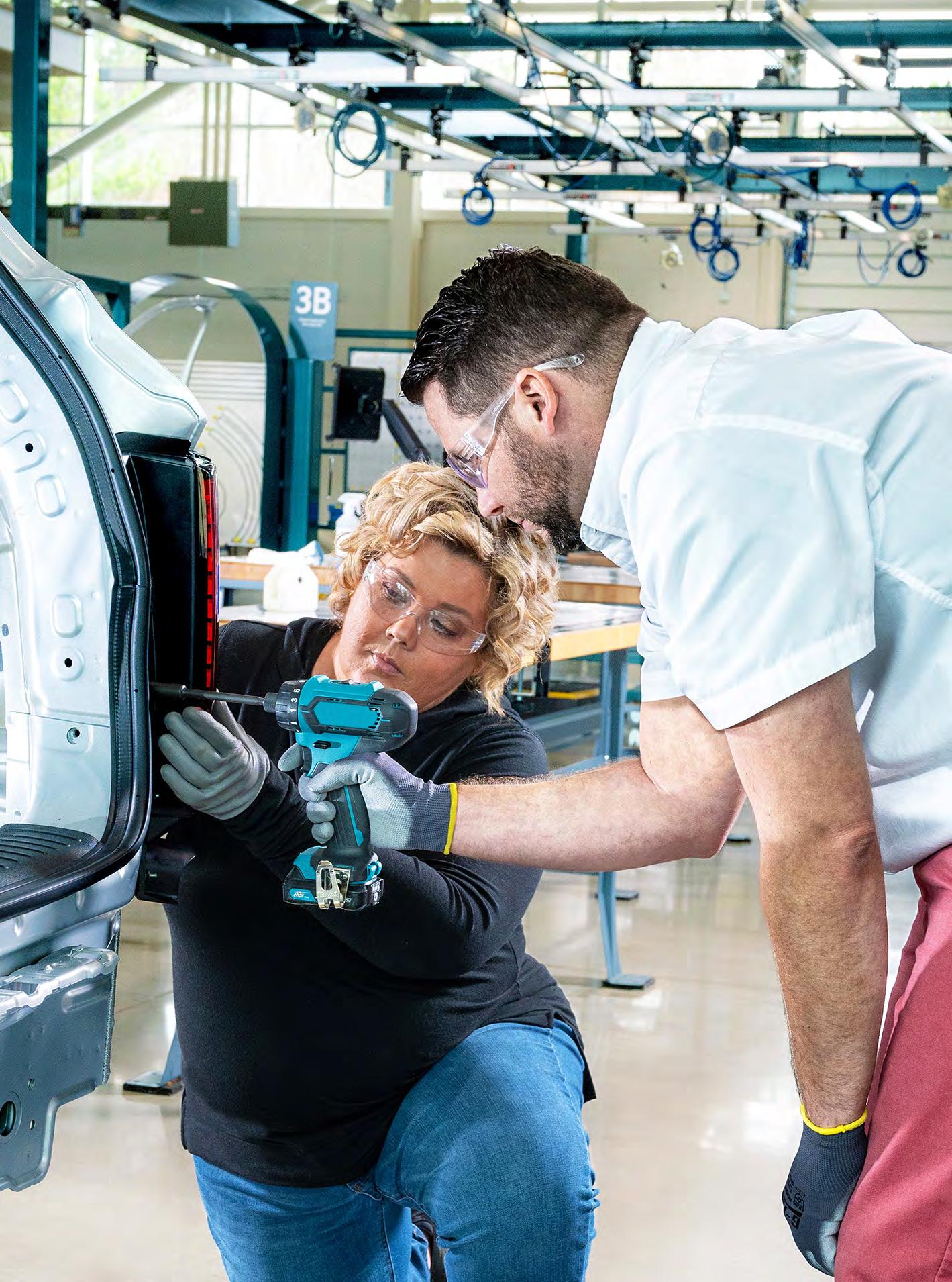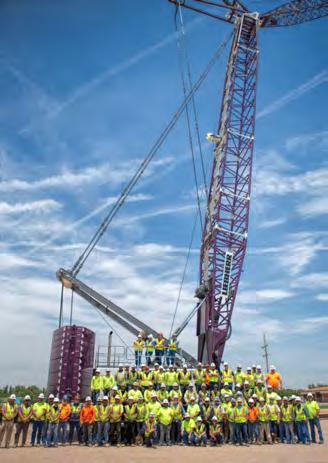













www.areadevelopment.com GIANTS CLASH ALONG THE GRID UP NEXT FOR INDUSTRIAL IN 2024 P 18 P 8 NAVIGATING THE DIGITAL TRANSFORMATION P 41 PUBLIC-PRIVATE PARTNERSHIPS DEVELOPMENT AREA AREA COMPETES FOR SPACE ALONG THE GRID COMPETES FOR SPACE ALONG THE GRID NAVIGATING THE DIGITAL TRANSFORMATION RETHINKING INDUSTRIAL SITE SELECTION P 30 MANUFACTURING MOMENTUM IS BUILDING P 24 P 24

The Winds of Change are in Virginia. Dominion Energy’s Coastal Virginia Offshore Wind project is breaking new ground in the energy industry. The 8.8-million-megawatt project is the first offshore wind farm installed in federal waters, the first developed and owned by a utility company, and the largest offshore wind project under development in the United States — and a major pillar of Virginia’s efforts to meet increasing power demands while moving toward a reliable, affordable, and clean energy future.
Find your advantage at VEDP.org.
Coastal Virginia Offshore Wind
Virginia Looks to Renewables to Meet Long-Term Energy Needs
The best way to conceptualize Virginia’s energy ambitions is to look to its past supporting one of the most power-intensive industries in existence.
“Data Center Alley” in Loudoun County is the world’s largest concentration of hyperscale data centers — its capacity exceeds that of either China or Europe. The area requires massive energy to power and cool computers, servers, and virtual machines. Fueled in part by plans to add more hyperscale data centers, the demand for electricity in Virginia is forecast by Dominion Energy, Inc. to grow 5% annually, more than double the pace of growth in the decade before the pandemic.
While a significant portion of the expected increase in demand for energy will be driven by data centers, some additional demand will come as drivers switch from vehicles powered by gas to those powered by batteries. That’s even more true if Virginia sticks with previous plans to ban the sale of gas-powered vehicles in 2035.
The Three-Legged Stool
The traditional energy model is often described as a “three-legged stool” based on reliability, affordability, and environmental stewardship. Virginia has been on a gradual trajectory of expanding renewable energy over the last two decades. Three long-term factors have coalesced to create a period of potential growth in clean energy generation in Virginia:
• Investment in new energy infrastructure over many years by the state’s main electric utilities, Dominion Energy and Appalachian Power;
• Development of technology that brought the cost of renewable energy down sharply; and
• Continued development and investment in a tech-savvy workforce with the skills needed to build and maintain cutting-edge energy infrastructure.

Renewable energy in Virginia hit a major milestone in late 2023 when the Coastal Virginia Offshore Wind project received public final approval, paving the way for a wind farm that could power as many as 660,000 homes by 2026. Once completed, the project will be one of the largest offshore wind farms in the world.
“Both/And” Instead of “Either/Or”
With high projected growth, Virginia can’t afford to leave an energy stone unturned, which is why the Commonwealth of Virginia 2022 Energy Plan builds on the Virginia Clean Economy Act of 2020 to include both renewables (solar, offshore wind) and more traditional energy sources (nuclear, natural gas, hydrogen). While natural gas remains the Commonwealth’s primary
fuel for generating energy, Virginia continues to work toward reducing its use to zero by 2050.
The Commonwealth continues to aggressively pursue solar generation. Virginia is seeking $250 million through an Environmental Protection Agency program called “Solar for All” that will commit $7 billion across the country for residential solar, enabling millions of low-income households to access affordable and clean solar energy.
Virginia’s priority is to anticipate future energy challenges and build the capacity to mitigate them. That means using the data about expected demand to create goals, then using flexible means to get there.
This article was paid for and written by the Virginia Economic Development Partnership and approved by Area Development.
AREA DEVELOPMENT | Q1 2024 1
The first eight monopile foundations for the Coastal Virginia Offshore Wind commercial project arrived at Portsmouth Marine Terminal in October 2023. The project will provide 8.8 million megawatts of power when complete, enough to power up to 660,000 homes.














16 Up Next for Industrial in 2024
Here is a look at the normalizing sector’s upcoming supply, demand, and pricing outlook. .
20 Navigating the Digital Transformation
Courtney Dunbar, site selection and economic development lead at Burns & McDonnell, recently asked Matt Olson, Burns & McDonnell’s chief innovation officer, about how companies are navigating the digital transformation and its potential of fostering sustainable, resilient manufacturing practices.
Growth of the digital economy has put transmission-adjacent properties and the ability to interconnect at the forefront of the site selection process.
Features
22 Why Smaller May Be Better for Some Businesses
After records have been set for massive industrial spaces, the market has shifted to smaller buildings.

28 How to Break the Bad News: Navigating the Conversation When a Company Doesn’t Meet Expectations
When a company cannot meet the original parameters set by its project, communication is critical to identifying potential solutions.

30 Manufacturing Momentum Is Building
A desire to bring manufacturing closer to the consumer, recent federal funding initiatives, as well as access to a skilled workforce and reliable power among other advantages have converged to spur growth in construction of U.S. manufacturing facilities.
32 Public-Private Partnerships Incentivize Industrial
Development
Communities that embrace creative solutions and collaborative approaches are well-positioned to thrive and attract jobs and investment from the private sector.
64 Applied Learning Fuels Investment in Workforce Training Facilities
With tailwinds such as government incentives and changing vocational preferences, workforce training facilities are poised for continued growth throughout the U.S.

2 AREA DEVELOPMENT for free site information, visit us online at www.areadevelopment.com
Area Development® Site & Facility Planning (USPS 345-510) is published four times per year (Q1, Q2, Q3, and Q4) at Lancaster, PA, by Halcyon Business Publications, Inc., 30 Jericho Executive Plaza – Ste 400W Jericho, NY 11753. Periodicals postage paid at Jericho, NY, and additional offices. Single copies, $20. Yearly subscription U.S. & Canada, $75; foreign, $95. CONTENTS
Industry in the Era of the Electron C O VER STORY
24 Overall Vacancy While Up Is Still Healthy Rent growth remained positive in 2023 but cooled compared to the highs registered in 2022 Annual Rent Change (%) Growth Vacancy Rate (RHS) 22% 18% 14% -6% -10% 10% 8.7% 8% 5.2% 4.9% 5.2%
66 Making Hybrid More Human in 2024
From theory to action — CRE leaders are putting strategies in place to make the workspace a center of collaboration and innovation.


68
Small and mid-size firms — which account for most of our Corporate Survey respondents — are holding their plans for new and expanded facilities in check despite economic news being better than what had been predicted.
48

The responding consultants say economic pressures are creating the biggest potential impact for their clients’ location and expansion plans, with finding available skilled labor being the most important concern.
“We’ve got to make sure we’re building the energy source of the future, not just thinking about next year, but 10 years from now, 20 years from now. That’s why we’ve invested in solar, and wind, and biofuels, [and] energy efficient cars.”
Barack Obama (1961– )
6 Editor’s Note
72
8 Rethinking Industrial Site Selection: A Retail Perspective
10 Smart Building Resolutions for 2024
11 Solutions Needed for Truck Driver Shortage
12 Impact of the Latest Minimum Wage Increases
Brian
AREA DEVELOPMENT | Q1 2024 3
Annual Reports
Electric Power Demands Key to Location Decisions In Focus
Frontline
14 First Person
Murphy, Americas Power, Utilities & Renewables Tax Leader, EY
Index/Web
71 Ad
Directory
Last
Word
POSTMASTER: Send address changes to Area Development, Circulation Department, 30 Jericho Executive Plaza – Ste 400W Jericho, NY 11753. Subscribers requesting address changes must provide both old and new addresses. © Copyright 2024 by Area Development® magazine. ISSN: 1048-6534. Printed in the U.S.A. Area Development® is a registered trademark of Halcyon Business Publications, Inc.
Striking a Balance: Prioritizing Electric Infrastructure While Preparing for the Next Wave of Industrial Expansion
59 | Number 1 Q1 2024
Departments Volume
44th President of the United States
interconnected
Survey Corporate
The Dynamic Landscape of Logistics in Mexico Companies considering nearshoring operations to Mexico will find a resilient and
logistics network to handle their import and export processes. Annual38th
34
Annual20th Survey Consultants

Electric Power Demands Key to Location Decisions
Analysts say that the biggest barrier to getting consumers to purchase electric vehicles is the dearth of charging infrastructure. In fact, according to a CNBC poll,1 nearly half of Americans say they doubt they would purchase an EV as their next car, citing a lack of charging options as well as the high costs.
Looking at the situation from another angle, it’s not just consumers who are looking to “plug in” but industry as well. Courtland Robinson, a guest editor of this issue and an energy and location strategist, tells us that “access to electricity has materialized as a dominant location determinant in the corporate site selection process.” As the digital economy has grown, companies have begun to compete for transmission-adjacent properties.
Matt Olson, Burns & McDonnell’s chief innovation officer, who was interviewed by Courtney Dunbar, site selection director at Burns & McDonnell and another guest editor of this issue, agrees that today’s digital transformation of industry is prioritizing access to electricity. He notes that corporate site selectors are now focused on “electron superhighways spanning nearly 160,000 miles.” Courtney and Courtland conclude that striking a balance between “the demands of utility driven industrial projects and the diverse needs of developers and communities is paramount.”
Others responding to our 20th Annual Consultants Survey concur with Courtland Robinson and Matt Olson, ranking energy availability and costs among the top-10 site selection factors. It appears that as the digital transformation of industry continues, the consumption of electricity is only predicted to increase.2
Editor
1 https://www.bankrate.com/banking/federal-reserve/history-of-federal-funds-rate/ 2 https://insideevs.com/news/657660/us-electric-car-sales-january2023/
AREA DEVELOPMENT
Publisher Dennis J. Shea dshea@areadevelopment.com
Sydney Russell, Publisher 1965-1986
Business/Finance Assistant Barbara Olsen (ext. 225) olsen@areadevelopment.com finance@areadevelopment.com

Advertising/National Accounts advertising@areadevelopment.com
Editor Geraldine Gambale editor@areadevelopment.com
Staff and Contributing Editors
In-House Art & Design Circulation/Subscriptions circ@areadevelopment.com
Production Manager Jessica Whitebook jessica@areadevelopment.com
Business Development Manager Matthew Shea (ext. 231) mshea@areadevelopment.com
Guest Editors
Courtney Dunbar
Digital Media Manager Justin Shea (ext. 220) jshea@areadevelopment.com
Web Designer Carmela Emerson
Courtney Dunbar, CEcD, EDFP, AICP, manages the site selection consulting group at Burns & McDonnell. Her career has centered on industrial development, creating solutions for corporate and institutional clients around the world and delivering multimillion-dollar, bottom-line growth. She is actively engaged in industrial site planning, site selection, site certification, economic analysis and community planning. She is a sought-after speaker on topics related to economic development site preparedness, as well as a faculty instructor on topics of real estate and infrastructure development at both the Heartland Basic Economic Development Institute and the University of Oklahoma's Economic Development Institute.

Courtland Robinson
Over the last decade, Courtland Robinson has supported hundreds of industrial and commercial site selection projects, representing economic development interests through local, state, and Fortune 500 employment. Most recently, Courtland provided power-intensive site selection consulting services for one of the largest energy holdings companies in the U.S. Prior to that, he served as managing director for the Virginia Economic Development Partnership, where he oversaw the strategy and implementation of business development efforts in both Asia and North America.
EDITORS NOTE 4 AREA DEVELOPMENT for free site information, visit us online at www.areadevelopment.com
Q1 2024
www.areadevelopment.com
Lisa Bastian Mark Crawford Dan Emerson
Business Publications, Inc. President Dennis J. Shea Correspondence to: Area Development Magazine 30 Jericho Executive Plaza Suite 400 W Jericho, NY 11753 Phone: 516.338.0900 Toll Free: 800.735.2732 Fax: 516.338.0100
Steve Kaelble Mark Schantz Karen Thuermer Halcyon


2024 EDITORIAL ADVISORY BOARD

Scott Kupperman
Kupperman Location Solutions Founder








Amy Gerber
Cushman & Wakefield Executive Managing Director, Business Incentives Practice
Courtney Dunbar
Burns & McDonnell Site Selection & Economic Development Leader
Brian Gallagher
Graycor Vice President, Corporate Development
Chris Schwinden
Site Selection Group Partner
Scott J. Ziance
Vorys, Sater, Seymour and Pease LLP Partner and Economic Incentives Practice Leader
Lauren Berry
Maxis Advisors Senior Manager, Location Analysis and Incentives
Joe Dunlap
CBRE Consulting Managing Director, Supply Chain Advisory
Eric Stavriotis
CBRE Vice Chairman





Alexandra Segers
Tochi Advisors General Manager


Stephen Gray
Gray, Inc. President & CEO
Marc Beauchamp
Hickey Canada Managing Director
Chris Volney
CBRE Managing Director, Americas Consulting
Chris Chmura, Ph.D.
Chmura Economics & Analytics CEO & Founder

Courtland
Robinson
Energy & Location Strategist




Brian Corde
Atlas Insight Managing Partner
Dennis Cuneo
Walbridge Director, Site Selection Services
Bradley Migdal
Cushman & Wakefield Executive Managing Director, Business Incentives Practice
David Hickey
Hickey & Associates Managing Director
Matthew R. Powers
OnPace Partners Partner
Alan Reeves
Newmark Senior Managing Director

Dianne Jones
JLL Managing Director, Business and Economic Incentives
6 AREA DEVELOPMENT for free site information, visit us online at www.areadevelopment.com

#5 Business Incentives Program in U.S. #7 Overall Cost of Doing Business 5% Corporate Tax Rate 20% Below National Average Cost of Living mississippi.org More leverage for your bottom line. GET MIGHTY.
FOCUS
Rethinking Industrial Site Selection: A Retail Perspective
The idea of putting the needs of the potential workforce first when making the location decision mirrors retail’s tradition of prioritizing customer satisfaction.
BY EVAN L. STAIR, Managing Director, Analytics, Vista Site Selection
In the dynamic world of industrial real estate, the art of pinpointing the ideal location for business operations is experiencing a profound evolution. Gone are the days when decisions were made solely on the basis of logistics and bottomline costs. In a refreshing twist, savvy companies are now borrowing a page from the retail sector’s book, embracing a strategy that places the spotlight on an often-overlooked aspect: the workforce. This innovative approach mirrors the retail industry’s longstanding tradition of prioritizing customer satisfaction, underscoring a significant shift toward a more peoplecentered business model.
Traditionally, the quest for the perfect industrial site was dictated by logistical imperatives — proximity to transportation arteries, supplier accessibility, and the allure of cost efficiencies. Yet, in today’s competitive landscape, where attracting and retaining top-tier talent has become a Herculean task, businesses are compelled to rethink their priorities. The modern industrial site selection process now ventures beyond the conventional, aiming to create environments that cater not just to the operational machinations of business but to the holistic well-being
and engagement of the workforce.
Adopting tactics reminiscent of retail’s savvy in engaging customers, businesses are meticulously analyzing workforce demographics, lifestyle inclinations, and the pulse of local communities to infor m their site selection. Imagine an industrial powerhouse opting for a location not just for its logistical conveniences but for its vibrant community, rich in amenities and educational opportunities, poised to attract the skilled workers essential for its operations.
This paradigm shift extends its reach into recruitment and workplace ethos. In a move akin to retail’s targeted marketing strategies, industrial entities are harnessing the power of digital platforms and social media to woo potential employees, showcasing not just job openings but a vision of a fulfilling career within innovative and sustainable workspaces. These environments are designed with an eye towards promoting health, well-being, and a commitment to environmental stewardship.
Prioritizing Employee Satisfaction
Illustrative of this trend are companies making strategic location decisions that align with their workforce’s needs. A tech firm may gravitate toward areas abuzz with academic institutions, ensuring a steady

influx of fresh talent, while a logistics enterprise might prioritize sites with robust public transport links, easing the daily commute for its team. Such decisions are a testament to a nuanced understanding that operational efficiency and employee satisfaction are two sides of the same coin.
Moreover, the emphasis on community engagement and forging meaningful partnerships with educational bodies echoes the retail industry’s knack for creating immersive customer experiences. Through these collaborations, businesses not only secure a pipeline of skilled labor but also cultivate a brand persona that resonates with community values and aspirations, thereby attracting a more engaged and dedicated workforce.
The narrative of reimagining industrial site selection, inspired by retail insights, is a harbinger of a broader movement toward sustainable, people-first business practices. This forwardthinking approach acknowledges employees as crucial stakeholders, whose preferences and needs are pivotal in shaping the future of industrial sites. Embracing this transformation, companies are poised to navigate the intricacies of the modern labor market with agility and foresight, ensuring their longevity and prosperity in an ever-evolving economic landscape. This story, rich in innovation and strategic acumen, invites readers to contemplate a future where businesses flourish by putting people at the heart of their operations, heralding a new era in industrial site selection.
8 AREA DEVELOPMENT for free site information, visit us online at www.areadevelopment.com IN




A Division of the Missouri Department of Economic Development
Smart Building Resolutions for 2024
By John Fleming, Vice President, Global Development for Sustainable Infrastructure at Johnson Controls
Building owners may look at the new year as a time to make good on goals they set for their buildings in previous years – whether that means upgrading outdated technology, focusing on net-zero carbon goals, or enhancing occupant experience.
The key to reaching any of these lies in the strategic advancement of smart building initiatives by building owners. This can look different for each building depending on the needs, goals, and budget set in place for a given year. However, certain steps should be considered before embarking on the
journey to transform an existing structure into a smart building.
1. Revisit your priorities. The first step in determining a direction is understanding where you’re starting from. Have priorities shifted? Should they? What are your goals around automation, deferred maintenance, improving building performance and more, and how are you getting there?
2. Ask these questions: Create a list and prioritize setting time with teams to uncover the following:
• How can we increase energy and water efficiency to reduce operating costs?
• What are our opportunities to automate manual tasks to manage labor shortages and boost productivity?
A new year brings fresh opportunities to elevate your building in order to reach your energy and infrastructure goals.
• How do we plan to tackle deferred maintenance to ensure continued operation?
• What are our plans to improve building performance to meet sustainability mandates?
3. Walk the terrain. See how your priorities are playing out across facilities. If you’re focused on reducing energy costs, are you having discussions around controlling energy use? Or if you’re aiming to streamline workflows, pay attention to what’s happening manually day-to-day. Put yourself in each situation to see how things are currently being done and how they can be improved.

4. Find a trusted advisor and schedule assessments (often). Work with an expert to learn what technology and infrastructure options are available for your specific needs. Once a partnership has been made, it’s time to assess your building’s current state – look at your building holistically to help address opportunities to upgrade indoor air quality, energy efficiency, security, and more.
5. Maximize available funding. Understand the cost of upgrades and retrofits then look to take advantage of any government initiatives or innovative funding approaches. How is the infrastructure bill impacting your work? What are the financing options available to you based on your energy efficiency goals? Will your city or county provide support if you meet certain criteria? Knowing the answers to these questions can help lower your stress while bringing your project to life.
Proactive measures taken early will help prevent costly and unwanted infrastructure challenges in the future. A new year brings fresh opportunities to elevate your building in order to reach your energy and infrastructure goals. Setting resolutions and sticking with them will ensure your smart building stands strong in 2024 and beyond.
10 AREA DEVELOPMENT for free site information, visit us online at www.areadevelopment.com IN FOCUS
FRONT LINE
Solutions Needed for Truck Driver Shortage
The supply chain continues to be negatively affected by a shortage of long-haul truckers, in particular, but recruiting more military veterans and women may be part of the solution.
BY DAN EMERSON
No one would dispute the importance of the trucking industry in the U.S. supply chain. Truck drivers transport more than 70 percent of the nation’s goods across the country. However, the industry has been hamstrung by a shortage of long-haul truckers. The American Trucking Associations (ATA) estimates that the industry will need to hire nearly 1.2 million new drivers over the next decade to replace truckers leaving due to retirement or other reasons.1
Increasing pay and other incentives have helped the industry attract new drivers, says Steve Viscelli, a sociologist at the University of Pennsylvania and the author of the book The Big Rig: Trucking and the Decline of the American Dream, but there are not enough new drivers entering the industry each year to make a significant difference in the shortage — especially in the longhaul, for-hire truckload sector, the part of the industry most acutely impacted by the shortage.
The average trucking company has a one-year turnover rate of roughly 95 percent, according to Trucking Info.com.2 Why the high turnover? Industry observers say the primary reason is poor working conditions that
make long-haul trucking an undesirable profession.
One of the major root causes of those problems was the deregulation of the industry in the 1980s, which, over time, transformed trucking from a steady, wellpaid profession to poorlypaying gig work with long hours, according to Viscelli. Today’s drivers earn about 40 percent less than they did in the late 1970s, Viscelli says, but are twice as productive as they were then.
Now that truck drivers are gig workers, the inefficiencies of the supply chain are making the jobs worse and worse. Viscelli says the solution to the retention problem “has been known for a while — higher pay, and pay for all the work,” which includes the time drivers spend waiting for their cargo to be loaded, and overtime work caused by that delay. By contract, drivers for some employers are supposed to get “extra” pay for that time, “but they have to ask for it,” Viscelli told Area Development. “That model of putting inefficiency on drivers and having the cost come out of their paycheck is a fundamental problem,” he explains. However, one of the models that has emerged is having a local driver who is being paid hourly assemble loads, so they are ready to go, which “dramatically improves the

experience” for long-haul drivers.
Some Solutions
In 2023, Reps. Mike Gallagher (R-WI) and Abigail Spanberger (D-VA) reintroduced their bipartisan Strengthening Supply Chains Through Truck Driver Incentives Act, which would provide a short-term, fast, and straightforward incentive to attract and retain new drivers. The GallagherSpanberger bill would create a two-year refundable tax credit of up to $7,500 for truck drivers holding a valid Class A commercial driver’s license (CDL) who drive at least 1,900 hours in the year. It would also establish new incentives for Americans to enter registered trucking apprenticeships.
To recruit more long-haul drivers, there are at least two under-utilized categories of workers — women and military veterans, according to experts.
The Biden-Harris Administration’s plan to address supply chain problems includes “focused” outreach and recruitment of veterans, with the help of the various service branches. There are an estimated 70,000 vets who are “likely” to have certified trucking experience within the last five years, according
to the Department of Labor’s Veterans Employment and Training Service. The plan also includes reducing barriers to drivers getting commercial driving licenses and encouraging more Registered Apprenticeships.
Women drivers are grossly under-represented in the trucking industry, according to government statistics, accounting for only 4.8 percent of the 1.37 million drivers in the U.S., as of 2021.3 Gender discrimination and sexual harassment are major causes, according to industry experts. Trucking companies often refuse to hire women if they do not have women available to train them. Because there are few female trainers to meet the need, same-sex training policies are common across the industry, truckers say, even though a federal judge ruled in 2014 that it was unlawful for a trucking company to require that female job candidates be paired only with female trainers.
1 https://www.prnewswire.com/ news-releases/ata-drivershortage-remains-near-recordhigh-301658985.html
2 https://www.nytimes. com/2022/09/28/business/ driverless-trucks-highways.html
3 https://www.nytimes. com/2023/10/05/business/ economy/women-truck-drivers. html?searchResultPosition=8
AREA DEVELOPMENT | Q1 2024 11
FRONT LINE
Impact of the Latest Minimum Wage Increases
The new year brings some significant changes that will impact employers who have entry-level workers, with 22 states raising their minimum wages effective January 1st.
BY DAN EMERSON
The impact of raising the minimum wage has been a perennial topic of debate. The new changes come in the midst of what continues to be a historically tight labor market, with heightened competition among employers looking for workers.
However, in the modern era, many manufacturers are less impacted by minimum wage requirements than in the past, since today’s manufacturers tend to rely less on low-skill workers. Even so, for manufacturers, “it has been challenging the last few years not only to find skilled employees, but also to find entry-level workers,” says Kathy Mussio of New Jersey-based consulting firm Atlas Insight. “Some manufacturers have lines idling because they can’t find enough people.”
Many manufacturers had already adjusted before the most recent January 1st minimum wage hikes took effect, according to Mussio. There were labor shortages pre-Covid, but the pandemic made the labor shortage problem even worse for many.
Automating processes can be a partial solution to the labor shortage problem, along with other ways to streamline, cut waste, and find other operational efficiencies. “But manufacturers are not thinking, ‘I’ll
automate so I can fire more people.’ They’re focused on how to make more product, increase their efficiency, and minimize downtime,” Mussio says.
While manufacturing in the U.S. has evolved to incorporate more technology and automation in the process, “not all manufacturing is easy or clean,” she points out. “We’ve come a long way, but there are still some manufacturing jobs where the plant floor is loud, hot, and sometimes even dirty.”
For a jobseeker choosing between working in a loud, sometimes hot manufacturing plant for $15 an hour, or working at an air-conditioned warehouse stocking shelves for $15 an hour, the manufacturing job option may well seem less appealing.
Absorbing the Increase

“Not every manufacturer has a high profit margin. If labor costs increase further, squeezing the profit margin for lower margin businesses, the higher wage costs will have to get passed on somewhere,” Mussio points out. The higher labor costs get passed ultimately to customers, increasing the cost of the goods. While some companies do try their best to absorb some of these increased labor costs, at some point, “they have to get passed along.”
The higher labor costs get passed ultimately to customers, increasing the cost of the goods.
Labor is very cost-sensitive. If minimum wage increases require employers to pay lower-end workers more per hour, that typically leads to pay increases for those who are above them on the corporate “ladder.” And companies vary widely in their ability to absorb wage increases.
Along with raising prices, there are other ways to absorb minimum wage increases — especially long-term — experts say. Those include making processes more efficient, investing more in technology, outsourcing some “noncore” functions, increasing and improving employee training, and adopting part-time or flex staffing.
Employers who have workers employed in “remote” locations need to be aware of the difference in minimum wage in a particular state and even locally where the remote
employee is working. “For example, you may have an entry-level employee working remotely, and while the employer may be located in a low minimum wage state and city, you typically would be required to pay at least the state and local minimum wage where the entry-level remote employee works,” Mussio explains.
A study released in 2023 by economists at Wharton University and several other institutions1 shed some new light on the minimum wage debate. One of their conclusions is that raising the minimum wage does not automatically guarantee workers higher income, employment, and welfare in the long run.
The authors suggested a more effective way to improve the long-term situation of low-income workers than large increases in the minimum wage. Combining existing “transfer programs,” such as the earned-income tax credit, or a progressive tax system, with a modest increase in the minimum wage provides even larger welfare gains for those workers, according to the study.
1 https://knowledge.wharton.upenn. edu/article/why-raising-theminimum-wage-has-short-termbenefits-but-long-term-costs/
12 AREA DEVELOPMENT for free site information, visit us online at www.areadevelopment.com

Some of the best educated, most productive workers in the country live here. They send their children to America’s best public schools. And they’re a perfect fit for complex engineering challenges, like the space suits made for NASA at Collins Aerospace. Tomorrow is here in Connecticut. advancect.org

FIRST PERSON

BRIAN MURPHY, AMERICAS POWER, UTILITIES & RENEWABLES TAX LEADER EY
The Inflation Reduction Act passed in 2022 will provide approximately $270 billion in tax incentives to stimulate the nation’s clean energy industry. Do manufacturers need to meet certain requirements to qualify for the tax credits and other financial inducements?
Murphy: To receive the credits and/or incentives outlined in the IRA such as the Advanced Manufacturing Tax Credit (45X) or the Advanced Energy Project Investment Tax Credit (48C), manufacturing companies must meet certain criteria. For 45X, eligible outputs or “components” are organized into five buckets: inverters, solar energy, wind energy, qualifying battery and applicable critical minerals. As a
manufacturer, if output falls into one of those categories, then the taxpayer is generally qualified for the credit Guidance recently stated that the amount of credit received is entirely dependent on the component produced; the origin of subcomponents and other inputs does not impact a taxpayer’s ability to claim the credit for U.S.-based manufacturing of eligible components (i.e., 45X does not have a domestic content rule). For 48C, during the first round of funding, manufacturers had to apply for each of their individual facilities, ensure the eligible property had not yet been placed in service, and “submit an application narrative, an application workforce and community engagement plan, a business entity certification, an application data sheet and appendix files.” When the second round of funding opens in 2024, manufacturers who did not apply in the first round should look to follow the same instructions. It’s worth noting that after an allocation is received, taxpayers have a four-year window in which to place the project in service.
Among the federal agencies through which IRA funds will flow are the departments of the Treasury as well as Agriculture, Energy, and the EPA, the latter three receiving $120 billion combined to promote renewable, clean energy and accelerate key U.S. sustainability goals. How does this tie in with manufacturers’ ESG goals?
Murphy: In addition to reducing carbon emissions (“E”) in the U.S., the IRA has a number of critical and socially (“S”) focused objectives including elevating wages, retraining people, developing careers, restoring impacted communities, and bringing critical manufacturing back to the U.S. Having the IRA’s funds flow through these federal agencies also promotes and facilitates the establishment of stricter, and necessary, environmental regulations and standards (“G”). By concentrating funds and incentives on a sustainability and carbon reduction agenda, energy and related manufacturing companies pursuing these incentives will directly advance federal policy objectives while also elevating and accelerating their own ESG-related goals and objectives.
14 AREA DEVELOPMENT for free site information, visit us online at www.areadevelopment.com
Why is collaboration between a company’s tax and finance departments and those charged with meeting its ESG goals important?
Murphy: The opportunities for synergies between tax, finance, and operations departments, with those focused on ESG-related goals and reporting, have expanded significantly with the IRA. According to a recent study by Morningstar,1 corporate tax risk is rising, and tax transparency is an absolute necessity for shareholders. Companies qualifying for incentives under the IRA typically have significant ESG-style requirements to secure the benefits. By proactively embracing both these increasing shareholder expectations and IRA compliance obligations, companies can position themselves as leaders in responsible financial reporting and gain a competitive advantage. These reporting requirements continue to progress (as we recently saw in December’s FASB update2) and will continue to evolve over time — which is all the more reason for tax teams to be (or remain) at an organization’s “ESG center.”
Considering the amount of data gathering needed to comply with the IRA, tax departments should look to work closely with the relevant divisions within their organization to ensure goal alignment. A key opportunity is to ensure that data gathered is being utilized to not only comply with the IRA, but to provide shareholders and investors with the necessary information to measure and track company progress related to ESG or related sustainability objectives. With tax playing such a centralized role in communications between the critical departments (HR, finance, procurement, legal, accounting, etc.), tight coordination will likely streamline the effort to confirm ESG goals are being met while also remaining compliant from a reporting standpoint.
What
reporting mechanisms will companies need to put in place to show that they are in compliance with sustainability and other goals they have set?
Murphy: As reporting requirements evolve, so should the company’s data collection. Information gathering is important, but companies often don’t have streamlined processes in place to handle the true scope of their reporting needs. Collecting and analyzing data for reporting can be complex, and more and
The opportunities for synergies between tax, finance, and operations departments have expanded significantly with the IRA.
more companies are requiring in-depth process reviews to ensure compliance. By proactively addressing these challenges and investing in the right technology solutions, companies can maintain accurate, efficient, and timely reporting. In 2024, companies must consider reporting requirements linked to the SEC’s proposed carbon and ESG reporting, as well as ensuring that tax benefits are being realized and properly reflected in business plans when working with vendors, contractors, and regulators.
Is there anything else you’d like to add?
Murphy: The convergence of tax policy and ESG related requirements in the U.S. creates a unique opportunity for companies to develop their data collection processes in a manner that will satisfy and promote multiple objectives. Tax departments need to have a seat at a company’s ESG table, and by embracing the transformative power of total tax contribution reporting, companies can strive toward a more transparent, inclusive, and responsible global business environment.
1 https://www.morningstar.com/sustainable-investing/tax-risk-isgrowing-companies-trouble-ahead-cisco-systems-microsoft
2 https://tax.thomsonreuters.com/news/newly-issued-fasb-rulesrequire-fuller-disclosure-of-taxes-paid-in-us-other-countries/
THE ASSIGNMENT
The Inflation Reduction Act (IRA) of 2022 set aside $369 billion for investments in clean energy and advancing key U.S. sustainability goals. Brian Murphy of EY was asked by Area Development’s editor how tax and finance can collaborate to advance a company’s key sustainability goals. To read EY’s full paper on this topic, go to https:// www.ey.com/en_us/power-utilities/tax-andfinance-to-lead-key-provisions-of-ira
AREA DEVELOPMENT | Q1 2024 15
Up Next for Industrial in 2024
Here is a look at the normalizing sector’s upcoming supply, demand, and pricing outlook.
 SBy Jason Price, Americas Head of Logistics & Industrial Research, Cushman & Wakefield
SBy Jason Price, Americas Head of Logistics & Industrial Research, Cushman & Wakefield
everal trends guide what is ultimately a normalizing industrial sector after back-to-back years of pandemic-fueled growth. Though we’re observing a slowdown and industry recessions across some industrial sectors, several factors show us that the sector overall is looking healthy.
Changes are coming for absorption as driven by demand. Coming off frenetic years in 2021 and 2022, industrial net absorption downshifted in 2023. For context, in 2021 and 2022 combined, the market absorbed just under 1.1 billion square feet, which is about twice the norm — meaning that four years’ worth of demand occurred in just a two-year timeframe. We estimate that roughly half of this demand came from pull-forward impacts, as companies — namely those tied to online shopping — had to build out facilities networks sooner than planned.
The flip side of this surge is that it “borrowed” demand from the future, which is one reason why we expected demand to moderate meaningfully this year and next. We’re forecasting vacancy to continue to edge higher in 2024, especially in the first half of the year. However, context matters. Cushman & Wakefield has been tracking industrial data going back to 1995, and from 1995 to 2019, the U.S. industrial vacancy rate averaged 8 percent. The industrial boom that we observed over the last few years brought vacancy down to 2.8 percent in Q2 2022, which is more than twice as tight as the market had ever been. Now, we’re observing the inverse effect as demand slows.
Downward trends in goods consumption will also lessen the pace at which occupiers scale moving forward. While real incomes are now rising, consumers also face higher interest rates, a labor market in the early stages
Overall Vacancy While Up Is Still Healthy
Rent growth remained positive in 2023 but cooled compared to the highs registered in 2022
16 AREA DEVELOPMENT for free site information, visit us online at www.areadevelopment.com > MARKET ANALYSIS
Source: Cushman & Wakefield Research Annual Rent Change (%) Rent Growth Vacancy Rate (RHS) 22% 18% 14% 10% 6% 2% -2% -6% -10% 200920102011201220132014201520162017201820192020202120222023 10.8% 10.8% 10% 8.7% 8% 7% 5.9% 5.2% 4.8% 4.5% 4.7% 4.9% 3.3% 3.1% 5.2% 10% Source: Cushman & Wakefield Research

Development-ready sites. Powerful incentives. Unrivaled global transport infrastructure. Explore the advantages at OpportunityLouisiana.gov/sites. 6 Interstates Certified Sites Incentives 6 Class 1 Railroads 6 Deepwater Ports IT ALL LEADS TO LOUISIANA
There is a finite window of about 18 months in which occupiers may find a slightly easier market to navigate, but that will quickly fade in 2025 as vacancy begins to recompress.
of softening, and an affordability crunch across the largest household budget line items. Given these formidable headwinds that will ultimately translate into weaker demand for goods, global trade flows will slow, and freight markets will remain oversupplied in the near-term.
Some occupiers are looking for new product to lessen the pressure on the market, but a decent share of the existing pipeline is accounted for, and development will taper off quickly as construction starts (measured in square feet) were down by 60 percent in 2023. Of the 452 msf currently under way, 114 msf is build-to-suit, and 23 percent of the total is preleased. The abundance of vacant spec product, while confronting a softer demand backdrop, still places an upper bound on vacancy. We still have approximately 330 msf of industrial product anticipated to deliver throughout the year, and as the new vacant speculative supply delivers, we’ll continue to see that upward pressure on vacancies, and our U.S. rate should peak around 6 percent.
There is a finite window of about 18 months in which occupiers may find a slightly easier market to navigate, but that will quickly fade in 2025 as vacancy begins to recompress. As we head to the second half of the decade, we forecast demand to return to its pre-pandemic pace (around 275 to 300 msf per year), while completions start to ramp back up. The current supply-demand imbalance will reverse, and vacancy will return to sub-5 percent.
Vacancy is our single most important predictor of where rent growth will head. Gearing down from just under 21 percent year-over-year (YOY) growth in 2022, we finished 2023 with rent growth at 10 percent YOY, and we expect that to be followed by approximately 4 percent in 2024.
There will undoubtedly be variation across markets and within markets. Some cities are structurally supply constrained due to land scarcity or zoning, while others will benefit from demand shifts (like being a cheaper inland market near expensive coastal cities). In almost all cases, vacancy will remain historically tight and demand for last-mile space, in particular, will remain fiercely competitive. The bottom line: Although there are some nearter m headwinds, the industrial sector still has extremely strong longer-term tailwinds. Rents are projected to start to reaccelerate in the second half of 2025 and into 2026, and industrial is demonstrating sustainable levels of rental rate growth — just not those double-digit growth rates that were recorded throughout 2022 and most of 2023.
Overall, expect absorption to moderate but remain positive, vacancy to rise but remain below long-term historical averages, and rents to tick higher — albeit at a slower rate. These are the signs of a normalizing market.
Industrial Absorption Decelerates in 2023
Source: Cushman & Wakefield Research
18 AREA DEVELOPMENT for free site information, visit us online at www.areadevelopment.com
Just under 1.1 billion square feet absorbed from 2021 to 2022 Net Absorption (MSF) 2020 2021 2022 2023 600 500 400 300 200 100 0

YOUR FUTURE
IS IN OUR SITES
in tennessee, you don’t have to look far for perfectly prepared sites. each site that bears our name is backed by the most rigorous set of site selection standards. when you consider your next project, look no further than tennessee.
experience all that tennessee has to offer at tnecd.com.
Navigating the Digital Transformation
Courtney Dunbar, site selection lead at Burns & McDonnell, recently asked Matt Olson, Burns & McDonnell’s chief innovation officer, about how companies are navigating the digital transformation and its potential of fostering sustainable, resilient manufacturing practices.


Dunbar: How did the COVID-19 pandemic impact the U.S. economy and industrial landscape, setting the stage for the digital transformation?
Olson: The COVID-19 pandemic delivered a harsh blow to the U.S. economy, triggering a deep recession and uneven recovery. While the government intervened with stimulus measures, industries reliant on in-person interaction like travel and retail were hit hard. However, this crisis also spurred a dramatic shift towards digitalization.
Lockdowns and social distancing measures necessitated a rapid adoption of remote work, benefiting industries like telecommunications and cloud computing. Consumers turned to online shopping, boosting e-commerce and lo gistics sectors. Businesses across various fields accelerated automation processes to adapt to labor shortages. These trends exposed the limitations of traditional models and highlighted the need for a digital future
This realization ushered in the “digital transformation.” Businesses embraced digital tools like cloud solutions and collaboration software. The remote work trend normalized, fostering a long-term shift in work culture and the growth of the digital workforce. The pandemic also exposed the critical need for robust digital infrastructure, paving the way for investments in reliable broadband Internet to support remote activities across various sectors.
Dunbar : How does the digital transformation impact corporate site selection, particularly in the context of electricity consumption and the expansion of energy prospectors?
Olson: The landscape of corporate site selection, particularly for clean energy components and advanced technology manufacturers, now prioritizes access to electricity as a primary determinant. The market’s focus has shifted toward transmission-adjacent properties, experiencing high demand from manufacturers, data centers, and various sectors vying for real estate along high-voltage corridors — electron superhighways spanning nearly 160,000 miles. This shift underscores the strategic importance of transmission-adjacent real estate in the corporate site selection process.
In addition, the recognition of supply chain leakage for critical components to support products produced in the U.S. has led to heightened demand for either reshoring or manufacturing duplicity that is putting significant strain on power availability. Aging transmission and distribution infrastructure, coupled with rising demand, has led to an environment where electric demand is outpacing electric availability.
Dunbar: How do labor force constraints, e-commerce trends, and the rise of cloud computing contribute to the increasing electricity consumption in industries?
Olson: The motivators pushing industrial occupiers toward higher levels of electricity consumption are multifaceted. Labor force constraints, including a shortage of skilled workers, coupled with the ascent of e-commerce and the demand for cloud computing, are compelling corporations to analyze more data and operate with fewer people. The resultant digital economy underscores the significance of transmission-adjacent real estate, making it a forefront consideration in the site selection process.
Dunbar: How can technology address labor shortages in manufacturing facilities, especially in the context of the digital transformation?
Olson: Technology plays a pivotal role in addressing labor shortages by leveraging advanced automation and robotics. The digital transformation, characterized by the bridge between digital possibilities and industrial realities built with electrons, aligns with the implementation of technology in manufacturing. Automation handles repetitive tasks, freeing up human workers for more complex roles. Predictive analytics and workforce management software are valuable tools that can help forecast poten -
The landscape of corporate site selection…now prioritizes access to electricity as a primary determinant.
20 AREA DEVELOPMENT for free site information, visit us online at www.areadevelopment.com > SUSTAINABILITY
tial labor shortages, enabling proactive adjustments in staffing levels and the implementation of training programs.
Dunbar: How can manufacturing facilities reduce their carbon footprint, and how does this align with the broader push toward sustainability in the industrial sector?
Olson: Achieving sustainability involves adopting ecofriendly practices and leveraging technology. The focus on renewable energy sources, energy-efficient machinery, smart building technologies, and energy storage in manufacturing facilities mirrors the broader industrial push toward a lower carbon footprint. Many industrial processes need heat, driving industrial carbon emissions; by using thermal heat batteries, we can turn low-carbon intermittent energy sources into reliable 24/7 power sources needed for industrial work. By integrating these technologies, manufacturing facilities contribute to reducing environmental impact and promoting leaner, more ef ficient operations with lower goods costs.
Dunbar: How can technology enhance supply chain resilience, and what role does it play in addressing disruptions?
The focus on renewable energy sources…in manufacturing facilities mirrors the broader industrial push toward a lower carbon footprint.
strategy, and what role does risk mitigation play in site selection?
Olson: Recent economic development announcements and pressures, coupled with the digital transformation, continue to reverberate through 2024. Risk mitigation, a core aspect of site selection, demands a higher degree of collaboration. While electric service delivery and scalability remain crucial, they must be managed alongside considerations such as water availability, labor demands, supply chain modeling, and other real estate criteria. Industrial occupiers are urged to adopt a utility-first and an all-of-the-above approach to site selection.
Dunbar: How do these technological advancements collectively shape the industrial landscape, and what should

The best LOCATION on the web to help with your corporate LOCATION needs. The best LOCATION to start your site and facility search. The best LOCATION to stay on top of industry needs. The best LOCATION for the newest and most relevant industry produced studies and research papers. LOCATION. LOCATION. LOCATION. Visit www.areadevelopment.com
Why Smaller May Be Better for Some Businesses
Although records have been set for massive industrial spaces, the market has been shifting to smaller buildings.
By Tim Logan, Partner at Parker Poe

The market for industrial projects exploded during the COVID-19 pandemic when the industrial real estate market pushed a frenetic pace for expansion. In 2021 and 2022 new developments were planned for major distributors and logistics companies that needed more space to meet demand from consumers who were spending more time at home, completing home improvement projects, or rushing to set up remote offices.
The construction pipeline to build large, 100,000-plus square foot industrial sites was seemingly bursting at the seams. At its peak in 2021, the U.S. industrial market set records by completing nearly 400 million square feet of new construction, according to data from Colliers, a real estate services firm. To add to that impressive statistic, the market was also seeing historically low vacancy rates of around 4 percent coupled with record high asking prices for rent.
But today, the industrial market may be moving in a different direction. Demand dropped over the past several quarters and vacancy rates stand a percent higher at the end of 2023 , according to Colliers. Construction starts dropped off last year compared to new heights reached two years ago. Developers started construction on nearly 90 million square feet of industrial space in the U.S. in the third quarter of 2023, down by about half of a record 176 million square feet of starts during the third quarter from the previous year, according to Colliers.
As the market rights itself to pre-pandemic levels, a post-pandemic demand trend is emerging in the industrial market: building space for smaller end-users. Those companies that struggled to find the right facility in the 10,000 to 49,000 square foot range at the height of the industrial market boom are again looking for space.
Benefits of Building Smaller Industrial Sites
As that happens, developers will find there’s still a demand for smaller space. Companies looking to relocate or expand can find success in smaller industrial sites, which for the most part did not see the same boom in new development. As developers navigate the industrial market landscape, it’s important that smaller sites are considered to meet the demand.
At the height of the industrial market boom, most developers and investors were in search of credit tenants to fill 100,000-plus square feet spaces. The underlying financial prowess of these large tenants makes them less risky tenants because they are much more likely to be able to continue paying rent in the event of a lease or market disruption.
But leasing to multiple smaller tenants can also reduce the risk of new development by allowing developers to diversify their portfolios. Using this model, developers can diversify not only through different companies, but also different industry sectors and lease expiration dates. The risk of taking on a smaller tenant with less financial might is softened by the potential for other tenants to continue rent payments after one tenant vacates the property or its lease terminates in accordance with its terms.
During the development and construction phase of industrial developments, a flexible space allows developers to fur ther hedge risk until tenants can be identified. Developers have found success following a model of designing a large project that can be easily subdivided into spaces or multiple buildings.
Advance design planning on issues such as the placement and style of loading docks and tenant parking allows
22 AREA DEVELOPMENT for free site information, visit us online at www.areadevelopment.com > ASSET MANAGEMENT
Leasing to multiple smaller tenants can also reduce the risk of new development by allowing developers to diversify their portfolios.
a developer to seek a credit tenant for an entire project or divide space into multiple suites capable of a diversified portfolio of tenants.
The shift to smaller industrial sites comes with other benefits. It frees up users and investors from only looking at large sites that are increasingly rare close to larger population centers. Smaller sites can naturally fit on overlooked pieces of land that are closer to an urban core, the workforce, and key transportation arteries.
Even if a large site becomes available, it is still possible to develop smaller sites in stages. Property restrictions can
be drawn that give a developer great control over the nature of development, architectural consistency within a project, use restrictions or grants of exclusive users, and shared expenses for common amenities to the site. A patient developer can have great flexibility in dictating what can be built and when.
Final Takeaways
Vacancy rates may be high across the industrial market, but a need for smaller, flexible spaces for tenants may present an ongoing development opportunity.
The pandemic created a high demand for industrial space, which developers rushed to meet. As vacancy rates begin to creep up, the question today is what types of spaces are most in demand. With so much development of large spaces in the past two years, the need by companies for smaller spaces could remain as an area for continued development.
Tim P. Logan is a partner at law firm Parker Poe. He advises companies and individuals in the acquisition, sale, development, leasing, and financing of commercial real estate. He can be reached at timlogan@parkerpoe.com.

AREA DEVELOPMENT | Q1 2024 23
Photo: Kettering University
 By
By




C O VER STORY 24 AREA DEVELOPMENT for free site information, visit us online at www.areadevelopment.com > INDUSTRY IN THE
OF THE ELECTRON
ERA
Location Strategist Growth of the digital economy has put transmission-adjacent properties and the ability to interconnect at the forefront of the site selection process.
Courtland Robinson, Energy &

Along the backbone of the nation’s power grid is an expanded chessboard of energy prospectors posturing for control of power-intensive industrial real estate.
In 2020, the Unites States recorded a 49 percent drop in foreign direct investment (FDI)1, the U.S. economy contracted 3.5 percent2, and the country lost 9.4 million jobs during the COVID-19 pandemic.3 While uncertainty surrounding the pandemic and many other variables painted a negative picture for the economy in the following years, what went down as one of the deepest recessions in U.S. history ended up being one of the shortest, lasting only a few months. Federal stimulus quickly reignited GDP and global FDI flows in 2021 shot up 64 percent above 2020 levels4 — a pendulum-swing that catalyzed the digitalization of industry, prompted large-scale manufacturing construction projects around the country, and ushered in an era of unprecedented industrial electric demand.
A digital renaissance has now ballooned across industrial and commercial segments. A measure of market potential for clean energy component and advanced technology manufacturers, access to electricity has materialized as a dominant location determinant in the corporate site selection process. Along the backbone of the nation’s power grid is an expanded chessboard of energy prospectors posturing for control of power-intensive industrial real estate.
Reborn
Today, in pursuit of business capabilities forged only by data and advanced analytics, the bridge between digital possibilities and industrial realities is built with electrons. Electricity consumption required to scale cloud-based technologies is challenging transmission capacity in parts of the country, complicating project timelines following a significant surge in manufacturing construction.5 While today’s contenders for power are not new, they are reborn — each attempting to solve for headwinds that require additional quantities of power. Among the motivators pushing industrial occupiers toward higher levels of consumption are a concurrent shift in consumer habits and desire for digital goods and services, labor force constraints including a shortage of skilled workers, the continued ascension of e-commerce, carbon emission targets, mounting overhead costs, and the rise of AI and cloud computing.
Simultaneously, federal legislation introducing tax credits and incentives strengthened the business case for large investments within energy-intensive industries. These pervasive conditions have created a fresh environment for competition among different real estate classes, as transmission-adjacent properties across the country swarm with interested parties of all segments and sizes.
Semiconductor fabrication plants, electric vehicle and grid-scale battery manufacturers, data centers, solar panel producers, along with other sectors emboldened by private equity and tax credits, race to secure real estate along these high-voltage corridors — electron superhighways that connect the U.S. through nearly 160,000 miles of line. 6
Positioning for scalability in a crowded field, manufacturers commercializing innovative technologies move expeditiously through the site selection process, often without the abundance of historical data to forecast facility loads. Navigating these considerations while defending a gainst a trailing competitive position, models sometimes rely on inflated power demands to hedge against operating constraints or extrapolate data from pilot plants testing new production technologies. Fluctuating production targets, along with innovations in manufacturing technologies and process design, add to the complexity of these projects and further cloud the variance between usage prediction and meter readings.
One thing, however, is clear. The digital economy that we are quickly building suggests that transmission-adjacent real estate, and moreover the ability to interconnect, will continue to be at the forefront of the site selection process.
Industries in Perspective
Accelerated by shifting U.S. work habits, a switch to cloud-based technologies, and the use of AI, data center growth is soaring. Data centers now consider consolidation, growth in nontraditional markets, and investments into energy storage and generation as methods to rise above challenges related to the cost of capital, supply chain constraints, and issues with transmission-level interconnections. Energy density requirements to support processing power are hitting record levels, with “hyperscale” developers sometimes requiring peak demands between 500–1,000 megawatts (MW), approaching the generating capacity of a single nuclear reactor.
Driven in part by recent legislation — notably the Inflation Reduction Act and Chips and Science Act — electricvehicle, battery, and semiconductor projects have also raced to the grid. The U.S. Treasury reports that $100 billion in private-sector investment has been announced across the clean vehicle and battery supply chain. 7 Electrode, cell, module and packs, and other battery grade components manufacturing have inundated power-rich sites across the automotive belt and beyond. Similarly,
AREA DEVELOPMENT | Q1 2024 25
semiconductor announcements have swallowed large chunks of generating capacity in some U.S. markets, as larger fabrication campuses approaching full buildout can require a peak demand upwards of 1,200 MW.
Warehouse and distribution centers are lowering operating costs, reducing maintenance, and supporting sustainability goals by automating operations and adopting electric fleets. A large distribution center combined with an electric shorthaul fleet needs upwards of 15 MW at peak demand. Another way to look at the transportation sector’s potential impact on a single circuit — 50 Class 8 trucks/tractor trailers require approximately nine MW of peak demand availability, equal to that of New York City’s Empire State Building.
The buildout of refrigerated storage is another critical and more capital-intensive component to warehousing and logistics. However, the U.S. has struggled to keep up with ecommerce’s Covid-induced home-cooking and grocery shopping trends, despite millions of square feet of temperaturecontrolled storage space being added in recent years. On average, refrigerated warehouses consume upwards of 25 kilowatt-hours (kWh) of electricity per square foot. This puts the average 100,000-square-foot cold storage facility at a peak demand of 3.5 MW, equivalent to the needs of approximately 1,700 households.
Endgame
The steady advance of intelligent technologies and electrification will further etch power’s footing within industrial real estate strategy. While grid modernization, investments supporting greater transmission and generation capacities, and the commercialization of advanced energy systems will ultimately allow for much of this electrification to occur in concert, recent pressures placed by historically large U.S. economic development announcements will continue to reverberate through 2024.
Risk mitigation, the essence of site selection, has never demanded a higher degree of collaboration. Certainly, electric service delivery and scalability still need to be managed along with other pressing considerations including water availability, labor demands, supply chain modeling, and other real estate criteria. Industrial occupiers of all sizes should heed the utility-first and all-of-the-above approach to site selection.
1 https://unctad.org/news/global-foreign-direct-investment-fell-42-2020-outlookremains-weak#:~:text=The%20United%20States%20recorded%20a,mostly%20in%20 the%20primary%20sector
2 https://www.bea.gov/news/2021/gross-domestic-product-third-estimate-gdpindustry-and-corporate-profits-4th-quarter-and
3 https://www.bls.gov/opub/mlr/2021/article/covid-19-ends-longest-employmentexpansion-in-ces-history.htm
4 https://unctad.org/news/global-foreign-investment-recovered-pre-pandemic-levels2021-uncertainty-looms
5 https://www.census.gov/construction/c30/pdf/release.pdf
6 https://www.ncsl.org/environment-and-natural-resources/electric-transmissionplanning-a-primer-for-state-legislatures
7 https://home.treasury.gov/news/press-releases/jy1939
26 AREA DEVELOPMENT for free site information, visit us online at www.areadevelopment.com Who
Area Development Magazine The industry’s most respected magazine since 1965 Digital Media AreaDevelopment.com & Newsletters The leading website for corporate site and facility planning Face to Face Consultants Forums The industry’s leading best practices conference events for economic developers Let us work with you. Add to your marketing success. Area Development Magazine 30 Jericho Executive Plaza, Suite 400W Jericho, NY 11753 516-338-0900 Fax: 516-338-0100 www.areadevelopment.com
we are. What we do. Print Media


Cut through the noise.




Labor market insights to lead the way.


For site selection, workforce planning, and all your growth goals, JobsEQ by Chmura helps you synthesize traditional labor market data with real-time job posting data in one convenient platform. Cut through the noise with powerful analytics that neatly display information on demographics, industries, occupations, wages, and more. Discover how you can move your community or organization ahead with accurate and timely labor market data from Chmura. Schedule your free demo at www.chmura.com/demo.
Features
Cloud-Based Software
Access JobsEQ from anywhere, at any time.
Customizable for a User’s Needs
Create custom regions, industry groups, occupation groups, forecasts, and more.
Schedule your free demo at www.chmura.com/demo.
Intuitive Workflows
JobsEQ walks you through the steps you need to answer your research question.
Maps & Charts
Tell your region’s story with clear maps and charts.
Live Chat
Get a response to your question from a real economist, in less than a minute.
Forecasts
Find out what industries and occupations will be in-demand in the future.
How to Break the Bad News: Navigating the Conversation When a Company Doesn’t Meet Expectations
When a company cannot meet the original parameters set by its project, communication is critical to identifying potential solutions.
By Ben Worrell, Principal, McGuire Sponsel
“Hey, we need to set up a call to discuss some changes with the project…” This correspondence always triggers a red flag — the project could be increasing substantially. However, those positive indicators usually cause further embellishment and urgency for a followup dialogue. The more ambiguous the communication, the less likely it is to indicate a positive outcome for the project.
Economic credits and incentives are inherently a “best guess” for the future. If we all had the magic crystal ball for predicting the future, we would likely use it for financial gains in Vegas! However, as we are trying to forecast the growth and success of projects five, 10, or even 20 years into the future, there is a risk that things don’t go quite as planned.

In fact, the best-laid plans never go the way they look on paper. As with most business ventures, flexibility is key in these circumstances. However, many incentive programs don’t have the necessary flexibility to adapt to project changes, for better or worse.
A Lot Can Happen
Site and facility planning projects are years in the making. Many projects start the planning process for site selection one to two years before any RFPs are sent out. Then, there is the scramble to complete and compete for the project. Once a project location has been decided and the economic incentives secured, the project is just “getting started.” In some circumstances, even small to medium-sized investments can take four to five years before the project sees its ribbon-cutting, first products going out the door, or first employees moving into their new offices.
A lot can happen in that amount of time. Regular communication with community stakeholders is required to overcome any hurdles along the way. Four years is the typical time for most political positions to encounter another election, from the national presidential race down to the local town council seat. Personalities, preferences,
and policies can all change, imposing risk on a company and its project. Risk is the chief enemy of most location projects. Experienced location advisory consultants stay in close contact with their clients throughout the development process to help navigate and mitigate risk and any challenges that arise from inevitable change.
But what happens when “changes” are insurmountable? Economies shift; buyers alter their practices; workforce becomes depleted; lead times extend; construction costs go to all-time highs — all these difficulties are recent realities in the post-pandemic world. If a company encounters the unexpected and needs to alter the project, it is the role of the location advisor to help navigate potential fiscal impacts on the project. Location advisors should work closely with community stakeholders to communicate changes and anticipate potential pitfalls for reporting and compliance.
Most economic incentives have a legal agreement between the taxing authority and the company. How flexible are these agreements? Often, contracts are fairly iron-clad. If the company meets the measures outlined early in the process, then it gets the benefit. But what happens when a company falls just short of the mark? Economic development officials should consider the levels of rigidity of their pro gram agreements. Some flexibility may be appropriate
28 AREA DEVELOPMENT for free site information, visit us online at www.areadevelopment.com > FACILITY PLANNING/ INCENTIVES
to anticipate the time required to make a project happen. Performance-based incentives can allow for this needed flexibility, but the delicate balance between the community’s interests and the company’s interests can be a tricky circumstance, especially when legal documents are years in advance of the project being completed.
Communication Is Key
When a company cannot meet the original parameters set by its project, communication is critical to identifying potential solutions. Early contact with economic development decision-makers is the best first step. Logical, clear explanations of the current circumstances are typically met with understanding, though there is likely to be disappointment. Remember, many incentives are offered due to the excitement generated by the potential project years before. The dreams of the project that “wer e to be” can be demoralizing for a community. Ideally, the project itself can still move forward, but in a dif ferent capacity. Again, flexibility within the economic incentive programs may help soften or lessen dramatic changes to project plans.
When projects consider an area, clawbacks are heavily weighted in the site selection process. Performance-
Economic credits and incentives are inherently a “best guess” for the future.
based incentives can vastly reduce a community’s risk in a project. However, those incentives shift that risk to the company. Certainly, non-performance should not be rewarded; however, careful review and reasonable extension of deadlines and compliance reporting could further considerations toward advancing a reduced project.
Working in economic development is like walking a tightrope between strict agreements and unforeseen challenges. Contracts offer stability, but all involved parties need to be flexible when projects take unexpected turns. Project advisors and stakeholders must communicate clearly and consistently to achieve practical solutions when things go awry. It’s all about finding that sweet spot between sticking to agreements and being adaptable. This approach can rescue projects, keeping the impact low and the original vision intact, even when the economic landscape throws us a curveball.

committed to Economic Development and a clean
future in

AREA DEVELOPMENT | Q1 2024 29
New York
We offer a wide range of economic development grants, rate discount programs, and energy efficiency rebate programs to help grow your business. Learn how our programs can benefit your business. Visit www.shovelready.com
We’re
energy
State.
Manufacturing Momentum Is Building
A desire to bring manufacturing closer to the consumer, recent federal funding initiatives, as well as access to a skilled workforce and reliable power among other advantages have converged to spur growth in construction of U.S. manufacturing facilities.
By Brian Gallagher, Vice President, Corporate Development, Graycor
Over the past three years, North America has witnessed many announcements regarding new and expanded manufacturing facilities. The pipeline for manufacturing development has reached an unprecedented level, indicating a solid trajectory for further growth in this sector.
Numerous factors have converged to build momentum and spur investment in manufacturing construction, creating a manufacturing renaissance in the United States. Various elements, such as supply chain complications, geopolitical unrest, energy costs, proximity to consumer bases, the impact of federal laws and funding initiatives, and emerging market dynamics influence this scenario.
While the broader economic landscape, monetary policy shifts, and prevailing market uncertainties have exerted varying degrees of influence on different industry sectors, capital investment in manufacturing facilities is strong. According to Census data, manufacturing-related construction hit a $210 billion annual rate in November 2023, more than triple the average rate in the 2010s. 1 Deloitte recently reported that manufacturing construction spending had the most significant annual increase in construction spending (65.5 percent) as of August 2023. 2
Key determinants influencing regional expansion trends in the manufacturing sector include land availability, cost-effective energy sources, robust logistics infrastructure, a conducive business climate, and a wellsupported labor environment, as outlined in an industry analysis by Newmark.3
According to the Newmark study, which analyzed significant manufacturing announcements in the U.S. over the past three years, nearly every state in the U.S. has benefited from recent announcements in manufacturing construction, with a notable focus in regions from the Midwest to the Southeast and Southwest. Texas and Arizona lead in investments, alongside Georgia and North Carolina. The study reveals substantial commitments in advanced manufacturing, totaling around $400 billion, expected to generate over 210,000 jobs and require constructing at least 250 million square feet by 2030. This manufacturing surge offers a timely boost to the construction industry amid a general slowdown in sectors like commercial, retail, and office construction due to economic factors.

Development in the U.S. supports advanced manufacturing, where information technology, automation, and more improve productivity, safety, sustainability, and innovation.
Market Trends Driving Development in the U.S.
The impact of COVID-19 on the global supply chain played a pivotal role in accelerating the trend of reshoring manufacturing to the U.S. The pandemic exposed vulnerabilities in international supply chains, leading many companies to reevaluate their reliance on distant suppliers. Disruptions in the production and transportation of critical goods highlighted the advantages of having manufacturing operations closer to home. This realization and the need for resilient and flexible supply chains fueled the urgency to restore production to the United States. Federal legislation and funding encouraging the construction of new facilities are adding fuel to the fire. The CHIPS and Science Act, the Infrastructure Investment and Jobs Act and the Inflation Reduction Act are just a few examples.
Megaproject announcements, characterized by budgets over $1 billion, have increased significantly. These projects stand out for their immense scale, complexity, and long duration, often involving sophisticated technol -
30 AREA DEVELOPMENT for free site information, visit us online at www.areadevelopment.com > MANUFACTURING TRENDS
ogy and organization. They significantly impact communities, economies, and the environment and require extensive economic development efforts, planning, and coordination among numerous stakeholders.
Several market sectors are experiencing growth, including:
• Semiconductor s: The demand for semiconductors is surging, and the U.S. is striving to reduce reliance on foreign suppliers by boosting domestic semiconductor manufacturing. The CHIPS Act supports investment by foreign and domestic firms in new chip facilities and their supply chain.
• Electric vehicles: With the global shift toward electric vehicles, the U.S. is positioning itself as a significant hub for EV production, leading to increased construction of EV manufacturing plants, battery recycling facilities, and production facilities for suppliers serving this industry.
• Advanced manufacturing: Advanced manufacturing is utilizing innovative technologies and methodologies to improve products, processes, and production operations. By integrating information technology, automation, computation, software, sensing, and networking, advanced manufacturing paves the way for more innovative, safer, and more environmentally sustainable production processes.
• Data centers: The digital age relies heavily on data centers, and the U.S. is witnessing a boom in data center construction to support the growing demand for cloud computing, artificial intelligence (AI), and data storage. While not technically manufacturing, data centers provide the backbone of data and communications.
• Life sciences: The pandemic underscored the importance of domestic pharmaceutical and medical supply production. Additionally, advances in research and development have led to new RNA and other medications.
• Energ y: T he evolution of the U.S. energy sector, primarily driven by the extensive implementation of hydraulic fracking in the early 2000s, marked a crucial turning point, igniting the drive to revitalize manufacturing. The transition from fossil fuels to more sustainable power generation sources has led to capital investments in manufacturing facilities to produce equipment for renewable energy generation, such as solar panels, batteries, hydrogen fuel cells, and other technologies.
The Attractive Benefits of Manufacturing in the U.S.
Manufacturing in the United States offers companies several benefits, including:
• Political stability: The United States, relative to other regions, boasts a stable political environment, providing a secure foundation for thriving businesses. The RussiaUkraine war and tensions between China and Taiwan are two examples of international instability. The relative
stability of the U.S. fosters investor confidence and reduces risks associated with manufacturing operations.
• Access to reliable power: The U.S. offers a robust and reliable power infrastructure, ensuring uninterrupted production processes. This reliability is critical for manufacturing operations dependent on a consistent energy supply.
• Skilled workforce: The U.S. has a highly skilled and adaptable workforce. Access to a skilled labor pool enables manufacturers to innovate and remain competitive in the global market.
• Proximity to clients: Manufacturing in the U.S. often means being closer to the consumer base. Reduced shipping costs and transit times make it advantageous for companies to manufacture products locally.
• Federal legislation and funding bills: The U.S. government has recognized the importance of manufacturing and has taken measures to incentivize companies to invest in domestic production. Federal legislation and funding bills provide grants, tax incentives, and other financial support to companies willing to bring production back to the U.S. The passage of the Infrastructure Investment and Jobs Act, CHIPS and Science Act, and Inflation Reduction Act has notably enhanced the domestic manufacturing construction sector.
• Automation: The U.S. is investing in automated production at a rapid pace. While robots require significant upfront capital investment, they can now build things more cheaply than workers can. The cost of automation is similar everywhere in the world. Automated manufacturing in the U.S. eliminates the strategic advantage of cheap labor from international competitors. Industries dependent on cheap labor as a strategic advantage will see their businesses disrupted by robotic automation, paving the way for a resurgence in U.S. manufacturing.
• Buy America: Several of the federal funding programs also include “Buy America” clauses, which mandate that a certain portion of materials are sourced from the U.S., or that final assembly must be completed in the U.S. This is also driving reshoring and investment in the states.
The manufacturing momentum will continue to be a key driver for capital investment in the U.S., likely with continued growth concentrated heavily in the Midwest, Southwest, and Southeast. Successes achieved up to this point in time will continue to build on themselves, creating a stable business environment where manufacturers can establish or expand their operations.
1 https://www.axios.com/2024/01/04/biden-factory-spending-manufacturingchips
2 https://www2.deloitte.com/us/en/insights/industry/engineering-andconstruction/engineering-and-construction-industry-outlook.html
3 https://www.nmrk.com/insights/thought-leadership/manufacturingmomentum-advanced-manufacturing-ascendancy-in-north-america
AREA DEVELOPMENT | Q1 2024 31
Public-Private Partnerships Incentivize Industrial Development
Communities that embrace creative solutions and collaborative approaches are well-positioned to thrive and attract jobs and investment from the private sector.
By Jenae Valentine, MSRED, Location Analysis and Incentives Manager, Maxis Advisors
Public-private partnerships (P3s) are vital to a community’s growth. Collaboration between the public and private sectors fosters development projects that result in creating or retaining jobs as well as adding to the tax base of a community.
Land development isn’t the only benefit to these partnerships, most communities have dedicated staff within their economic development or community development departments who serve as liaisons to help the private sector navigate the complexities of regulations and procedures. This role involves fostering relationships, streamlining processes, and championing projects that align with the community’s development needs. At the core, economic development professionals are charged with attracting new businesses, working to grow existing businesses, and supporting workforce development initiatives. They advocate for and support initiatives that contribute to the community’s economic well-being.
Speculative Development to Attract Industry
While P3 incentives for speculative industrial development are less of an interest to primary markets where there is already robust population growth and significant organic investment, often secondary and tertiary markets are willing to invest in P3s to support these types of projects. Over the past few years, the Maxis Advisors team has seen increased interest from government and utility partners to support speculative development projects in their respective markets.
Speculative development, in this context, refers to the construction of industrial properties without a precommitted tenant. Communities in these markets will set goals for development that allow them to take a strategic approach to proactively support and address the demand for new industrial space that aligns with their economic objectives. For example, an automotive OEM locates in a jurisdiction and the communities around the manufacturing facility know that suppliers to the OEM are going to set up operations in the region. These surrounding communities might engage with the private sector to establish a P3 that supports building speculative development, in hopes to appear more attractive and address speed-to-market demands from suppliers.
Key reasons for the heightened interest in speculative development support include:
• Job growth: Communities aim to attract or expand specific industries that can contribute to job creation. By developing new industrial spaces speculatively, they create an environment conducive to attracting businesses and, subsequently, fostering job growth.
• Diversification: Introducing new industrial product helps diversify the economic landscape of a community. By accommodating a variety of industries, communities can mitigate risks associated with relying heavily on specific sectors.
• Increased tax base: The development of new industrial properties contributes to the local tax base. As businesses occupy these spaces, they generate property taxes and other local revenues, providing the community with additional funds for public services and infrastructure.
• Speed to market: Speculative development can make a community more attractive to businesses seeking suitable locations for relocation or expansion. It positions the community as proactive and responsive to the evolving needs of the market.
Secondar y markets are typically within 30 to 45 minutes of major cities that boast large populations, universities, airports, and numerous amenities. In addition to major market proximity, these smaller communities have clear access to highways and interstates. For a developer, expanding their search from a core metropolitan area could increase site availability and reduce land costs for industrial development. Companies considering relocating or expanding their business into a secondary market could also benefit from lower real estate and labor costs.
The increasing attractiveness of secondary markets for developers and end-users gives local governments an opportunity to creatively support development projects. This discretionary support is often tailored on a case-by-case basis and may involve local government agencies, state authorities, and utility partners. Each community structures its support mechanisms differently.
Assessing Opportunities for Collaboration
Timing is crucial when exploring potential support from the public sector, and the due diligence phase of a project is an
32 AREA DEVELOPMENT for free site information, visit us online at www.areadevelopment.com > CRE/ PROJECT PLANNING
ideal time to assess opportunities for collaboration. This phase occurs when the development team conducts an in-depth analysis of various factors, including available land, construction costs, return on investment, market demand, and existing availability. During this process, the team identifies potential hurdles that may impact the project’s success. The due diligence period is a strategic window for initiating discussions with the public sector and economic development professionals.
In some communities, the local government can support development through a reimbursement of taxes paid once a building is delivered and on the tax roll. Tax increment financing (TIF) is another tool used by government to assist developers with infrastructure upgrades associated with a project. At the state level, departments such as the Department of Transportation could potentially support a project if infrastructure upgrades are aligned with projected plans for upgrades in the area. Each state will have a different structure for how they support projects. Infrastructure support from a state could be available through a fund with an earmarked amount of dollars that is tied to target industry sectors and job growth. These type of economic development grants could require coordination with the local government to apply for specific public infrastructure improvements that will support private development. Funding from the local and state government for a development project is typically tied to projected job growth and new investment.
Local utility partners could also be a resource when developing new product. Depending on the utility provider and the market it serves, there could be opportunities to receive funds for site development and energy-efficient building upgrades. Site infrastructure programs could potentially support water and sewer extensions, environmental studies, and road improvements needed at the site. Energy efficiency programs could include industrial building upgrades such as rebates for lighting and equipment, HVAC equipment, and industrial equipment.
Just like states, each community is different and will have different drivers and priorities when planning for growth. Navigating the bureaucratic processes of local government and aligning with the priorities of elected officials can indeed be challenging for private-sector developers and end-users. However, fostering collaboration between the public and private sectors is essential to create a win-win scenario for the community and developers/end users. Recognizing the strengths and capabilities of each sector is key to achieving successful and expedited project outcomes. Communities that evaluate their economic toolbox to ensure it aligns with their goals and future plans are better equipped to support the private sector and drive growth. A business-friendly community with staff that is respon-
sive, proactive, and open to collaboration is a true differentiator. The level of customer service the private sector experiences will influence a developer’s and company’s decision to invest in a community. This is especially crucial in a risk-averse industry such as commercial real estate where developers seek confidence and assurance when making substantial investments.
Economic development professionals in secondary markets can set themselves apart by taking a leadership role in facilitating discussions with internal departments and elected officials about development opportunities. Bringing together key representatives from different departments early in the development process allows for the identification of challenges and the exploration of potential solutions before they become significant obstacles.
A Valuable Approach
In today’s capital market environment securing support from local government is more crucial than ever to make development deals financially viable. Various challenges — including the rising costs of construction and materials, high interest rates, and more stringent lending practices from banks — have made it difficult for new industrial development projects to succeed. Additionally, the perception that “all the good sites are gone” and “if it hasn’t been developed yet, there’s a reason” often arises, but the reality is that many undeveloped sites face significant barriers to development.
Public-private partnerships (P3s) emerge as a valuable approach in overcoming these challenges. P3s provide a framework for addressing obstacles and creating thriving communities that attract the investments and jobs essential for sustained growth. Secondary and tertiary communities that embrace creative solutions and collaborative approaches are well-positioned to thrive and attract the jobs and investment desired by stakeholders in the community.
AREA DEVELOPMENT | Q1 2024 33
Annual38th Survey Corporate
By Steve Kaelble
Small and mid-size firms — which account for most of our Corporate Survey respondents — are holding their plans for new and expanded facilities in check despite economic news being better than what had been predicted.
34 AREA DEVELOPMENT for free site information, visit us online at www.areadevelopment.com
It really wasn’t that long ago that economists were warning of a rough ride ahead, and articles about the economy read like horror stories. Inflation was downright frightening — so bad that many experts believed only a recession and a big jump in joblessness would tame it. The proverbial “soft landing” seemed like an unlikely Hollywood plot twist.
But like most good stories, this one had a powerful element of surprise. The plot did, indeed, take an unexpected turn, with inflation slowing to near the Fed’s goal, even as the economy kept expanding and unemployment remained low.
What does that mean for corporate leaders, as they chart a path forward in 2024? What kind of story are they expecting to see, and how are they going to write their chapters in that story?
As it does every year, Area Development surveyed its corporate executive readers at the end of last year, inquiring about their plans and priorities for 2024, particularly those that will impact how and where their companies grow. We’ll get to the results in a minute, but here are two spoilers. First, the top site selection factor on our survey respondents’ minds is the same one that they were thinking about a year earlier, and a year before that. But second, a lot of what they’re pondering right now is markedly different from a year earlier.
A Profile of the Respondents
The corporate executives who answered our questions this year are heavily involved in making or delivering things. Fully 60 percent represent manufacturers, and another 9 percent are involved in distribution and logistics. The finance, insurance, and real estate sector employs 9 percent of our respondents, 6 percent are in energy, and the rest are spread among such sectors as construction, business services, retailing/e-commerce, technology, and agriculture.
Of those who took part in the survey, three-fifths are the top dog: chairman, president, CEO, owner or partner. Almost a fifth are manager or director of a business unit. Other respondents hold a variety of high-level titles, from CFO or controller to vice president or secretary or other corporate officer. Still others are on the real estate side, including real estate VPs and managers and directors, as well as leaders in facilities and development. In short, they lead from different angles, but they’re all highly influential in their enterprises’ future direction.
As for the breadth of their operations, nearly twothirds have two or more facilities operating, and about a quarter have at least one facility in another country. About a third of the respondents work for companies employing between 100 and 499 people. A little over a third represent smaller companies with payrolls under 100, and the remainder are from companies employing 500 or more people.
Planning for Expansion
Clearly, not every company takes on a physical expansion in any given year. Two-thirds of this group of corporate respondents say they don’t expect their company will expand the physical footprint of their existing facilities in 2024, and two-thirds are not planning to open a new domestic facility.
But it’s not being a Pollyanna to see the bright side in those numbers, by looking at the flipside. Of the respondents, 35 percent say they plan a physical expansion of their U.S. facilities this year. To that good news, add the fact that 34 percent are planning to open a new domestic facility this year.
The respondents who said they have plans for a new domestic facility were asked for more details. What kind of facility, for example? Some picked more than one kind — 56 percent said a new manufacturing operation is in the works, half have plans for a new distribution center or warehouse, another fifth are planning a fulfillment center. A headquarters facility is in the cards for a quarter of those with projects in mind, and 13 percent are planning a back office or call center.
AREA DEVELOPMENT | Q1 2024 35
Manufacturing, Life Sciences Fueling Northern Kentucky’s Growth

Diverse industries are supporting manufacturing and employment growth in the “peak” of Kentucky.
Boone, Kenton, and Campbell counties are the “peak” of the Commonwealth of Kentucky and collectively make up Northern Kentucky (NKY) — where the Midwest meets the South and bourbon meets brewing fanaticism in the Cincinnati MSA. Our thriving region also boasts amazing assets including four professional sports teams, world-class parks and museums, and five Fortune 500 companies.
With a labor shed of 1.5 million people, NKY focuses on four industry sectors that lead our growing and diverse economy. These sectors, identified in a 2022 Target Industry Study by EY, include advanced manufacturing, life sciences, information technology, and supply chain management and support services.
Advanced manufacturing in NKY includes Tier 1 automotive, food and flavoring, aviation, and aerospace companies. These leaders performed strongly in the region in 2023, accounting for 69 percent of new proj-
ects and 56 percent of new jobs announced. BE NKY forecasts advanced manufacturing employment will grow by near double-digits through 2025.
Major expansions from Bakery Express Midwest, Matrix Pack North America, Castellini, and Safran Landing Systems Kentucky accounted for nearly 600 new job announcements in 2023. Safran produces and refurbishes advanced carbon composite brake disks and produces aluminum alloy wheels and brakes for large commercial and military aircraft.
“Safran Landing Systems is a key contributor to the Kentucky aerospace manufacturing industry, as reflected by our steady growth over the years,” said Philippe Garnier, CEO and general manager of Safran Landing Systems Kentucky. “This new investment will allow us to bolster our manufacturing capabilities with the addition of new equipment and strengthen our workforce to meet increased production volumes as we support our U.S. military and commercial customers.”
BE NKY expects employment in the life sciences industry to grow at an even greater rate of 30 percent for the
period 2020-2025. Major local companies include Bexion Pharmaceuticals, Gravity Diagnostics, Thermo Fisher Scientific, and CTI Clinical Trial and Consulting Services. Another unique life science asset includes the Wood Hudson Cancer Research Laboratory’s biospecimen repository, which houses more than two million human tissue cancer and non-cancer specimens.
The new OneNKY Center will house many NKY growth organizations, as well as the new Covington Life Science Lab. This lab will provide cost-effective research and development facilities with shared equipment and office space, as well as educational and training opportunities, to life science startup companies.
If you’ve been to Cincinnati, then you know the Cincinnati/Northern Kentucky International Airport (CVG) is in NKY. CVG currently ranks as the sixth-largest and fastest-growing cargo hub in North America thanks to a 149 percent increase from 2015 to 2022. DHL Express Global Superhub and Amazon Air cargo hub chose CVG for their North American operations. DHL and Amazon’s presence led directly to NKY’s cargo and MRO industry growth with companies like FEAM AERO, DHL (MRO), and Atlas Air contributing significantly.
Northern Kentucky is prosperous and has an outsized impact on the success of the Commonwealth of Kentucky and Greater Cincinnati region. Our leaders and community organizations, crossing county and city lines, are working collaboratively to grow the region and attract new companies and talent. When it comes to taking your businesses to new heights, the “peak” of Kentucky is second to none.
This article was paid for and written by the BE NKY Growth Partnership and approved by Area Development.
Gravity Diagnostics is a state-of-the-art CAP-accredited and CLIA-certified laboratory licensed in all 50 states, which provides innovative diagnostic testing in the areas of toxicology, pharmacogenetics, infectious and upper respiratory diseases, blood, and COVID-19.
36 AREA DEVELOPMENT for free site information, visit us online at www.areadevelopment.com
Courtesy of Gravity Diagnostics, Covington, KY


THE #1 REGION BUSINESSES CALL HOME. BE-NKY.COM #1 Best Regional Airport in North America Cincinnati/Northern Kentucky International Airport (CVG) #1 Best City in the Nation for College Grads #1 Lowest Cost of Living, Major Metros
Annual38th Survey Corporate
What inquiring minds really want to know, of course, is where those facilities will be located. The Midwest states are high on the list for 38 percent of the respondents. That said, the warm and business-friendly states of the South are highest on this list, with 44 percent of the respondents naming South Atlantic states, 31 percent with eyes on the Southwest, and a quarter pondering locations in other Southern states. About a fifth are looking in the Middle Atlantic region and a similar percent in Mountain states, as well as in Canada.
There’s been a lot of talk about re-shoring and nearshoring operations back to the U.S. or Puerto Rico, or to places such as Canada or Mexico. Of those planning new facilities, 19 percent say that’s what they’re doing in 2024, which is about as many as were re-shoring or nearshoring in 2023.
Additionally, since more than 70 percent of the survey respondents say they employ fewer than 500 people, it’s expected that their new facilities will also only create fewer than 500 jobs.
Also barely changing from 2023 to 2024 are the factors influencing overall expansion or investment plans. Roughly half say their 2024 plans are either greatly or moderately influenced by government initiatives, such as the CHIPS and Science Act or the Inflation Reduction Act. That’s about the same as 2023. Current economic conditions are greatly or moderately influencing expansion or investment plans in 2024 for 60 percent of respondents, same as last time around. In fact, about half say economic pressures are the factor most affecting expansion and investment plans in 2024 — again, same as for 2023, and that’s a fair amount more than those pointing to labor availability or supply chain issues.
Interestingly, it should come as no surprise that two thirds of our Corporate Survey respondents say their investment plans are influenced by getting to net-zero emissions and meeting sustainability goals.
Corporate Priorities When Picking a Site
In a world filled with change, here’s something that doesn’t seem to vary much from year to year: labor costs and availability of skilled labor are high on the priority list when corporate executives are considering future plans for their business. The top site selection factor in the most recent survey was the cost of labor, just as it was the year before, and before that, too.
38 AREA DEVELOPMENT for free site information, visit us online at www.areadevelopment.com
Site Selection Evolves
Corporate respondents prioritize workforce talent, environmental factors, and permitting/regulatory ease in their location and expansion decisions.
The Corporate Survey results shed light on the evolving landscape of site selection priorities. I was not surprised to see that workforce criteria continue to emerge as the top consideration. It correctly reflects how the current demographic crisis is leading to an enduring strategic focus on talent acquisition and retention.
This emphasis on workforce aligns with the needs observed in the EV, battery manufacturing, and battery recycling sectors, especially with assembly plants that require a large workforce and battery-material manufacturing facilities that require a pointed skillset.
The survey’s recognition of success factors such as environmental and permitting regulatory ease and access to low-cost renewable energy is aligned with our industry’s needs. Access to land and logistics infrastructure also resonates deeply within the EV battery recycling sector. With sustainability being a core pillar of the industry, access to renewable energy sources is critical for minimizing environmental impact. Battery recycling projects also require appropriate zoning and access to public infrastructure given the nature of the processes. Lastly, the need to access a global supply chain underscores the importance of a strategic location based on logistic considerations to reduce operational costs.
About half the respondents say that government funding has influenced expansion plans, which is especially the case for the EV battery recycling industry. In addition to the global shift toward electrified transportation, the unprecedented funding through the IRA and DOE loans have helped propel the industry which is expected to double in the next decade.
Overall, the alignment between the survey results and the priorities within the EV battery recycling industry underscores the interconnectedness of site selection strategies with broader industry trends and imperatives. As businesses continue to navigate an increasingly complex and dynamic landscape, prioritizing factors such as workforce development, sustainability, and logistical efficiency will be essential for driving growth and competitiveness in the evolving market environment.
By Isabel Cyr, Government Relations & Public Affairs Director, Lithion Technologies
AREA DEVELOPMENT | Q1 2024 39
Annual38th Survey Corporate
Forty-four percent of the respondents name South Atlantic states, 31 percent have eyes on the Southwest, and a quarter are pondering locations in other southern states [for new facilities].
More than 90 percent of the respondents say this factor is “very important” or “important.” That’s not particularly surprising, given the labor cost trends. Average compensation by the end of 2023 was rising at an 12-month-average rate of just over 4 percent, according to the U.S. Bureau of Labor Statistics,1 which in fairness is a whole point lower than the year before, but still more than a percentage point above what it had been averaging before the metric shot skyward in 2022.
Moving up from third to second on the list is the availability of skilled labor, with just under 90 percent placing this factor among the highest priorities. Again, no surprise, given that unemployment2 has headed downward ever since 2010, other than a couple years of pandemic pain that had fully eased by 2022.
Here’s where the story starts to diverge a bit from prior years. The third-most-important priority on the latest Corporate Survey ranking is the impact of environmental regulations, up from ninth place a year earlier. But perhaps that is also hardly surprising — with climate change in the headlines more and more, executives probably are rightly wondering how governmental regulation might evolve in response.
Tax exemptions also shot up the list, from 13th to fourth, cited as a “very important” or “important” factor by four-fifths of the respondents. With global electronic connections of ever-increasing importance, the quality and availability of information and computer technology bumped up a notch to fifth place.
Making a major upward move on the priority list for corporate executives is whether a potential site is in a right-to-work state. That could be a reflection of the politi-
40 AREA DEVELOPMENT for free site information, visit us online at www.areadevelopment.com
ACCESS GEORGIA’S DEPENDABLE TALENT

Georgia’s partnership-driven approach to workforce development sets our state apart. The high school College and Career Academies, top-ranked universities and colleges, and the nation’s #1 workforce training program equip Georgia’s diverse talent with the in-demand skills needed to succeed.
PIPELINE georgia.org/workforce
Current economic conditions are greatly or moderately influencing expansion or investment plans in 2024 for 60 percent of respondents, and half say these economic pressures are having more of an effect than supply chain challenges or workforce availability.
42 AREA DEVELOPMENT for free site information, visit us online at www.areadevelopment.com Annual38th Survey Corporate






Businesses aren’t the only thing we scale.
Businesses aren’t the only thing we scale.



Bold and exciting advancements are happening in the Grand Canyon state. Cutting-edge companies are launching, testing and scaling new technologies in Arizona. Our culture of innovation, highly skilled talent, lean regulatory environment, and affordable operating costs provide an ideal platform for business growth and success. The state has announced investment from industry leaders including Benchmark Electronics, JA Solar, LG Energy Solution, Lucid, Virgin Galactic, TSMC and more. Ranked top five for largest growing state, it’s clear why people are flocking here. Beyond being a place where you can achieve your professional goals, Arizona provides an unmatched lifestyle that allows you to achieve your personal goals. It’s this perfect balance that makes life better here.
azcommerce.com
cal climate and questions of whether change might be in the air in this area. Half the states have passed right-to-work laws since the 1940s. But the most recent move has been in the opposite direction — as of 2024, Michigan has reversed course and repealed its law.3 Along similar lines, nearly three-quarters of respondents are keeping a strong eye on a location’s low union profile, helping that factor move from 19th to 12th.
With so many things moving up the list, something had to move down. Quality of life was a second-place factor last survey and dropped to seventh in the current Corporate Survey. Energy availability was previously ranked fourth but dropped to 14th, though energy costs are still in the top 10, as they were last survey. Construction costs fell from fifth to 13th, though about 70 percent still think that’s a “very important” or “important” consideration.
Corporate tax rates retain a key place within the top 10, with about 77 percent of respondents seeing them as “very important” or “important.” Highway accessibility gets the same level of interest, climbing into the top 10 from the 11th spot before. Governmental officials will be interested to know that state and local incentives are of significant importance to about 74 percent of corporate executives, and nearly 70 percent say the same about the importance of a responsive state and local government.
44 AREA DEVELOPMENT for free site information, visit us online at www.areadevelopment.com Annual38th Survey Corporate
Site Selection Factors Very Important % Important % Minor Consideration % Of No Importance % Labor Availability of skilled labor 51.3 35.9 10.3 2.6 Training programs 31.6 31.6 29.0 7.9 Technical schools 32.4 32.4 24.3 10.8 Labor costs 52.5 40.0 7.5 0.0 Low union profile 55.2 18.4 10.5 15.8 Right-to-work state 51.4 27.0 10.8 10.8 Transportation/Telecommunications Highway accessibility 41.0 35.9 15.4 7.7 Railroad service 18.9 5.4 32.4 43.2 Accessibility to major airport 16.2 27.0 40.5 16.2 Waterway or oceanport 15.8 18.4 18.4 47.4 Energy availability 44.4 25.0 25.0 5.6 Energy costs 43.2 35.1 16.2 5.4 ICT/broadband 39.5 39.5 7.9 13.2 Finance Corporate tax rate 48.7 28.2 12.8 10.3 Tax exemptions 48.7 30.8 12.8 7.7 State and local incentives 44.7 31.6 15.8 7.9 Real Estate Available buildings 27.0 29.7 21.6 21.6 Available land 29.4 32.4 20.6 17.7 Construction costs 42.1 29.0 10.5 18.4 Expedited or “fast-track” permitting 42.1 23.7 15.8 18.4 Shovel-ready/certified sites 25.0 16.7 30.6 27.8 Other Raw materials availability 37.8 29.7 13.5 18.9 Water availability 29.7 13.5 27.0 29.7 Weather hazards 23.7 34.2 29.0 13.2 Environmental regulations 44.736.810.57.9 Proximity to major markets 37.527.522.512.5 Proximity to suppliers 27.827.833.311.1 ESG initiatives 21.121.126.331.6 Responsive state and local government 41.028.223.17.7 Quality-of-life 37.840.516.25.4 * All figures are percentages and are rounded to the nearest tenth of a percent.
CORPORATE SURVEY *
























AllinNC.com CNBC Top State for Business, 2022 & 2023 NORTH CAROLINA’S WORKFORCE DIDN’T BECOME #1 BY PROCRASTINATING. Talent is flocking to North Carolina to jump on the career opportunities that come with a booming economy and a thriving job market.
Annual38th Survey Corporate
Pessimism or Confidence?
To a certain extent, economic optimism — or lack thereof — can be a self-fulfilling prophecy. People and companies worried about the days ahead may pull back spending, and if they do, the results end up reflecting and reinforcing their jitters. It doesn’t always turn out that way, though. A year ago, we reported that 60 percent of those responding to the National Association of Manufacturers optimism survey4 were expecting a recession in 2023, and we all know how that turned out.
Nevertheless, manufacturers are still down in the dumps, according to the NAM’s survey5 from the fourth quarter of 2023. The optimism rates for small and mid-size firms were 65.9 and 63 percent, which NAM counts as historically low levels. Why so glum? Nearly 90 percent expect higher tax burdens that’ll make it tough to expand facilities or their workforce or invest in equipment. And it’s still a tough challenge attracting and retaining employees in this sector.
On the other hand, the 2024 Business Leaders Outlook from J.P. Morgan6 finds more than 80 percent of innovation economy business leaders confident about how their company and industry will fare in the year ahead. They are keeping a cautious eye on interest rates, cybersecurity issues, and the impacts of artificial intelligence, but they nevertheless have growth in mind.
And it certainly doesn’t hurt that consumers are feeling upbeat going into 2024, according to The Conference Board, whose Consumer Confidence Index7 hit a two-year high in January, up for the third straight month. According to its economic experts, consumer pessimism is “receding.”
1 https://www.bls.gov/news.release/pdf/eci.pdf
2 https://www.bls.gov/cps/
3 https://www.hrdive.com/news/michigan-right-to-workappeal/707562/
4 https://nam.org/2022-fourth-quarter-manufacturers-outlook-survey/
5 https://nam.org/2023-fourth-quarter-manufacturers-outlook-survey/ 6 https://www.jpmorgan.com/content/dam/jpmorgan/documents/ cb/insights/outlook/business-leaders-outlook/cb-2024-businessleaders-outlook-ie-international-ada.pdf
7 https://www.conference-board.org/topics/consumer-confidence
* �All
46 AREA DEVELOPMENT for free site information, visit us online at www.areadevelopment.com
figures are percentages and are the total of the “very important” and “important” ratings of the Area Development Corporate Survey and are rounded to the nearest tenth of a percent. * * 2022 ranking CORPORATE SURVEY
* Site Selection Factors 20232022 Ranking 1. Labor costs 92.5 89.1 (1)** 2. Availability of skilled labor 87.2 85.8 (3) 3. Environmental regulations 81.5 79.0 (9) 4. Tax exemptions 79.5 73.0 (13T) 5. ICT/broadband 79.0 80.7 (6) 6. Right-to-work state 78.4 66.7 (18) 7T. Quality-of-life 78.3 87.1 (2) 7T. Energy costs 78.3 79.4 (8) 9T. Corporate tax rate 76.9 79.7 (7) 9T. Highway accessibility 76.9 77.8 (11) 11. State and local incentives 76.3 73.0 (13T) 12. Low union profile 73.6 66.2 (19) 13. Construction costs 71.1 81.2 (5) 14. Energy availability 69.4 82.3 (4) 15. Responsive state & local government 69.2N/A 16 Raw materials availability 67.5 61.3 (22) 17. Expedited or “fast-track” permitting 65.8 70.3 (16) 18. Proximity to major market 65.0 74.6 (12) 19. Technical schools 64.8 67.2 (17) 20. Training programs 63.2 63.4 (21) 21. Available land 61.8 78.1 (10) 22. Weather hazards 57.9 54.8 (24) 23. Available buildings 56.7 71.9 (15) 24. Proximity to suppliers 55.6 64.5 (20) 25T. Accessibility to major airport 43.2 54.0 (25) 25T. Water availability 43.2 49.2 (27) 27. ESG initiatives 42.2 42.0 (29) 28. Shovel-ready/certified sites 41.7 55.7 (23) 29. Waterway or ocean port 34.2 27.0 (30) 30. Railroad service 24.3 23.8 (31)
COMBINED RATINGS

WATER HELPS ALL THINGS GROW, INCLUDING BUSINESSES.
For over 120 years, SRP has ensured that Greater Phoenix has had a reliable water supply — and that’s not changing any time soon.
As our residential and business populations continue to grow, we’re finding new ways to expand water storage capacity, use hydrologic data and activate long-term climate plans. If you’re searching for a new place to plant your business, Greater Phoenix has enough water to help it grow strong roots.
Get the full story at powertogrowphx.com.

Annual20th Survey Consultants
By Steve Kaelble


The responding consultants say economic pressures are creating the biggest potential impact for their clients’ location and expansion plans, with finding available skilled labor being the most important concern.
For site selection consultants, planning expansions and launching new locations is all in a day’s work. The respondents to Area Development’s annual Consultants Survey live and breathe this stuff, with their finger on the pulse of this business every day of the year.
It’s enlightening to not only examine their views on site selection priorities and challenges, but also compare them to the views of corporate executives, outlined in the companion article spotlighting the Area Development Corporate Survey. Only some corporate execs have location or expansion plans this year, but twice as many don’t. And of those who do, some corporate execs work with consultants, some don’t. Suffice it to say they’re often on the same page, but not always.
A Profile of the Respondents
Before we open the envelope and read the results, it’s worth learning about the consultants who shared their insights as well as the industries they’re active in helping. Two-thirds have worked on location and expansion projects in the automotive and battery sector, and about that many have had projects in clean and renewable energy. Nearly as many have clients in food processing. A little under half have been active in projects involving life sciences or biotech, and a similar share in consumer products.
Nearly all of the responding consultants have been working on manufacturing location or expansion projects, nearly three-fifths on distribution and warehouse deals, and two-fifths on R&D facilities. A similar number have worked on headquarters deals.
They’ve worked with clients of all sizes. Three-quarters have represented clients with 5,000 or more employees, three-fifths have clients employing between a hundred and 499 employees, about that many have clients with 500 to 999 on the payroll, and a little over half represent clients with employee counts between a thousand and 4,999.
AREA DEVELOPMENT | Q1 2024 49
Respondents worked on location and expansion projects in the following sectors: Back Office/Call Center 22% Data Center 30% Distribution/Warehouse 57% Fulfillment 20% Headquarters Office 41% Manufacturing 96% R&D/Innovation 41% Other 7%

Annual20th Survey Consultants
Making Plans With Clients
It goes without saying that pretty much all of the consultants surveyed have some plans on the drawing board for expansions and/or new facilities for their clients. It is, after all, why clients call them. But what kinds of plans are they making, and what things are influencing those plans?
Of the consultants responding, more than half are working on projects worth at least a thousand new jobs. Half are helping facilitate initiatives that’ll create at least 500 jobs, while three-fifths have a hand in new deals that’ll deliver between 250 and 499 jobs. The majority are in on projects that’ll take shape in the next six to 18 months, and two-fifths have projects with timelines even faster than that. And most of these consultants are working on some projects involving international companies or foreign direct investment.
Nearly 90 percent of the consultants responding say they have client projects that are either greatly or moderately affected by recent government legislation, such as the CHIPS and Science Act or the Inflation Reduction Act. The vast majority report plans that are greatly or moderately impacted by current economic conditions, and nearly half say economic pressures carry the biggest potential impact. Half of the consultants say clients will be either greatly or moderately impacted by the need to meet sustainability goals and even achieve “net zero” emissions.
As for where in the country they’re looking, nearly all consultants are working on projects in the South and South Atlantic states, four-fifths list projects in the Midwest, and more than three quarters also have locations or expansions going on in the Southwest. Two-fifths are dealing in the Middle Atlantic region. About a third have projects in Mountain states, about a third in Plains states, and the same can be said for both Canadian and Mexican locations.
What Consultants Prioritize
The top 10 site selection factors on the minds of consultants for 2024 are largely similar to what had their attention a year ago.
50 AREA DEVELOPMENT for free site information, visit us online at www.areadevelopment.com
Respondents worked on location and expansion projects in the following industries: Agriculture 15% Aerospace 35% Automotive/Batteries 67% Business Services 26% Consumer Products 44% Energy – Oil, Gas 24% Energy – Cleantech, Renewables 65% Financial Services 22% Food Processing 63% Life Sciences/Biotech 43% Medical Devices 20% Pharma 17% Raw Materials 24% Real Estate 13% Retail/E-Commerce 24% Semiconductors 31% Software/Technology 31% Transportation 17% Other 13% Respondents working with clients that have: 20-99 employees 37% 100-499 employees 61% 500-999 employees 63% 1,000–4,999 employees 56% 5,000 or more employees 74%
Extent to which recent government legislation (chips, inflation reduction, etc.) will affect your clients’ expansion/investment plans: Greatly 44% Moderately 43% Slightly 13% Not at all 0%



Kinetic Energy Attracting Investments Throughout Kansas
Kansas has earned its global reputation as a force in the renewable energy industry.
Manufacturers know they can produce more for less in centrally located Kansas. Proof of Kansas’ appeal has come amid the powerful push for more electric vehicles, as one of the nation’s largest EV battery manufacturing facilities is taking shape in De Soto, Kansas.
Panasonic Energy is building a new $4 billion, lithium-ion battery manufacturing plant — the biggest economic development project in Kansas history — with production set to begin in March 2025. Panasonic evaluated more than 100 potential sites in 12 states before choosing Kansas because of its skilled workforce, reliable infrastructure, central location, and shared commitment to clean and renewable energy.
The Panasonic project also is leading transformative economic growth throughout the state and region that goes beyond the 4,000 new jobs needed to operate the sprawling facility. The plant also will support an estimated 4,000 additional jobs created by suppliers and community businesses and 16,500 construction jobs — economic impact that will last for decades to come.
Energized Economic Development
Kansas’ world-class foundation for success — with cornerstones set in education, innovation, and a talented workforce — has fueled record-setting economic development achievement in the state. Kansas was No. 1 in economic growth in the third quarter of 2023 nationwide, and No. 2 in the second quarter. Since 2019, Kansas has attracted more than $18 billion in new capital investment and created and retained 66,000 jobs because of visionary efforts to modernize economic development and seize emerging opportunities.
The new Office of Registered Apprenticeship in the Kansas Department of Commerce is helping equip thousands
of Kansans with the skills, mentorship, and credentials they will need for successful careers in the energy industry, as well as healthcare, advanced manufacturing, and other industries. The Office of Innovation continues recruiting cutting-edge businesses, in part with

Development of new wind farms and a stronger supply chain have Kansas among the best states for operating wind farms and corporate wind purchases — helping Google, T-Mobile, Target, Kohler, Textron Aviation, Spirit AeroSystems, and others meet sustainability goals.
More wind power came recently when Danish energy giant Ørsted inaugurated a 200-megawatt Sunflower Wind project in Marion County, Kansas, that will generate enough clean energy to power 70,000 homes and numerous businesses.
Kansas also offers solutions for solar energy, with a well-trained workforce and customized training programs benefiting solar equipment manufacturers and suppliers. And Kansas is fourth among states in total biomass production, with economical access to feedstock for bio-based fuels. Kansas currently operates 12 biofuel facilities, with more ethanol and biodiesel facilities on the horizon. Plus, the potential of hydrogen has Overland Park company WindSoHy at the forefront of efforts to develop safe, non-polluting and cost-effective hydrogen technology.
Enhanced Energy Security
innovative energy solutions that have made Kansas the top place in the nation and world to do business.
Kansas also offers a diverse portfolio of financial incentives to businesses and producers engaged in conventional and renewable energy production.
Wind as a Driving Force
An ever-increasing percentage of the state’s energy comes from renewable sources — starting with truly potent wind energy. Kansas currently harnesses enough clean energy to power every single home in the state for a year, times two.
Kansas is in line for a major upgrade to the state’s electrical resilience and capacity, which will better prepare the state for weather emergencies, while also creating jobs. The federal Bipartisan Infrastructure Law project will help the state create a safer, more reliable and more cost-efficient power supply for families and businesses — and support local economic development projects and more clean energy in Kansas.
To learn more about doing business in Kansas, please visit kansascommerce.gov.
This article was paid for and written by the Kansas Department of Commerce and approved by Area Development.
A skilled workforce, outstanding transportation infrastructure, and ready access to natural resources have made Kansas a leader in renewable energy activities.
Courtesy of Kansas Department of Commerce
52 AREA DEVELOPMENT for free site information, visit us online at www.areadevelopment.com

Annual20
Survey Consultants

Manufacturing Projects Dominate the Deal Flow
The volume of manufacturing projects across the nation is rising, while office activity has been slow to recover from the pandemic.
Extent to which getting to “net zero” emissions and meeting sustainability goals will affect your clients’ expansion/investment plans:
Respondents are working on domestic location or expansion projects for the following regions:
The results of the 20th Annual Consultants Survey are very intriguing because it’s a way to calibrate project activity that we are personally seeing within Site Selection Group to that of our site selection consultant peers. Some of the results align closely to our project experience, but there are results of the survey that do not represent the bulk of our project pipeline.
It is not surprising to see that 96 percent of respondents worked on manufacturing location and expansion projects. Manufacturing projects dominate the deal flow and, in almost every industry article you read or industry event that you attend, you will hear about the volume of manufacturing projects that are occurring across the country.
What was surprising is that 41 percent of respondents worked on office/headquarters projects. Office activity has remained slow to recover from the pandemic. The office projects SSG has worked since the pandemic are heavily dominated in the call center/back office or shared services sector. However, we have noticed a shift with current projects to include more headquarters relocations. I suspect the 41 percent number will be higher in next year’s survey.
The other interesting result was 83 percent of respondents are working domestic location or expansion projects in the Midwest. This may be industry specific that is driving the activity level in the Midwest, but our project activity is predominantly South Atlantic, South, Southwest, and Mountain. The most activity level we are seeing in the Midwest is in Michigan, but it’s a very small percentage of projects compared to the Sun Belt, which is where 60–70 percent of our office projects are focused.
Overall, the results of the survey were very compelling, and it’s a great way to better understand the trends occurring within all industry sectors and within all geographic regions. It is also interesting to see the results pertaining to job creation and expected timeline.
By Brett Bayduss, Senior Partner, Site Selection Group
54 AREA DEVELOPMENT for free site information, visit us online at www.areadevelopment.com
th
Greatly 11% Moderately 39% Slightly 46% Not at all 4% Which of the following will most affect your clients’ expansion/ investment plans in 2024? Economic pressures 46% Energy availability and cost 20% Supply chain reliabilityș 7% Workforce, labor availability 26%
New England (CT, MA, ME, NH, RI, VT) 7% Middle Atlantic (DE, MD, NJ, NY, PA) 41% Midwest (IL, IN, MI, MO, MN, OH, WI) 83% South Atlantic (FL, GA, NC, SC, VA, WV) 93% South (AL, AR, KY, LA, MS, TN) 94% Plains (IA, KS, NE, ND, SD) 33% Mountain (CO, ID, MT, NV, UT, WY) 35% Southwest (AZ, NM, OK, TX) 78% Pacific (AK, CA, HI, OR, WA) 22% Canada 35% Mexico 33%

YOUR NEXT DESTINATION IS HERE. madeinalabama.com/next

Annual20
Survey Consultants
are unimportant to those responding to the Corporate Survey, but these factors tend to be slightly further down the executives’ list.
As for the old adage about “location, location, location,” which some say was first uttered about a century ago, consultants are still paying pretty close attention. Proximity to suppliers and major markets rate fairly high
Are you currently working with any international companies/foreign direct investment into U.S.?
Skilled Labor, Ample Energy, and Speed to Market Take Priority
A location’s labor availability; responsive, pro-business local partners; and ability to support a large energy user are often the main drivers of the site selection decision.
Once again, the ability to source abundant skilled labor tops the charts as the most valuable asset to a community. Companies have struggled for five years or more to find solid, deep pools of talent to support their operations, and consultants really have to perform a lot of due diligence in this space to ensure with the greatest level of reasonable certainty that their clients will have the people they need to support their operations. It is critical for us when we visit communities to not only see what the labor environment currently is but, moreover, what is the competition for labor coming into the community and how will the community continue to source its skilled workforce in the future.
The theme of the factors that tied for second in the Consultants Survey are primarily focused on speed. If a client comes to us, they already have a need and a timeline in their mind. If we are looking at several sites that score relatively similarly, [available land] that is fully entitled and shovel-ready most likely will leapfrog ahead of the other sites. It also helps when the local partners that we rely on are responsive and excited about our project. We want to find a community that welcomes the investment opportunity. And the role of incentives, as indicated by the responses, is one way that communities show that they are serious about winning the business. And it matters to our clients!Their impression of that community or region only goes up!
One of the fastest ways to get cut from a site selection is when we get to looking at energy capacities — both now and in the future. We are seeing areas of the country that we thought were very dependable for energy surprise us when it comes to the availability of energy or the timeline to get up to where our clients need to be. It is one of the first cuts we do when siting large operations. If a community does not have the ability to support a large energy user, it is always best to be direct about it to save time (and face!) for all parties. The sincerity will most likely earn a community a look for a more suitable project, but if there are unpleasant surprises, it could damage the site selectors’ chances of working with that community ever again.
By Gregg Healy, Executive Vice President, Head of Industrial Services, North America, Savills
56 AREA DEVELOPMENT for free site information, visit us online at www.areadevelopment.com
th
Yes 87% No 13% In terms of job creation, clients’ new facilities or facility expansions will create: Fewer than 100 jobs 50% 100–249 jobs 72% 250–499 jobs 59% 500–999 jobs 50% 1,000 or more jobs 56%
Expected timeline for these new facilities and/or facility expansions is: Less than 6 months 39% 6–12 months 59% 12–18 months 59% Greater than 18 months 37%


SILICON VALLEY, IF SILICON VALLEY HAD FOUR SEASONS.



MICHIGAN


As a top 10 state for R&D and innovation, Michigan has the advanced manufacturing, technology and talent that top companies need to build the next generation of transportation mobility and electrification. Discover why we’re the Silicon Valley of the Midwest and seize your opportunity at
MICHIGANBUSINESS.ORG PURE OPPORTUNITY
®
DETROIT

Annual20th Survey Consultants
It’s no surprise that the responding consultants are quite attuned to the responsiveness of state and local government.
on their list (eighth and 13th, respectively, both a fair amount higher than they are on the corporate executive ranking). Both consultants and executives list highway accessibility as a major factor, though.
* Site Selection Factors 20232022 Ranking 1. Availability of skilled labor 100.0 98.3 (1T**) 2T. State and local incentives 98.0 96.6 (3T) 2T. Available land 98.0 94.9 (7T) 2T. Responsive state & local government 98.0N/A 5. Energy availability 97.9 98.3 (1T) 6. Energy costs 93.9 96.5 (6) 7. Tax exemptions 91.7 89.7 (12T) 8T. Highway accessibility 89.8 94.9 (7T) 8T. Proximity to suppliers 89.8 94.9 (7T) 10. Labor costs 87.8 96.6 (3T) 11T. Environmental regulations 85.7 87.7 (14T) 11T. Water availability 85.7 81.1 (19) 13. Proximity to major markets 83.7 96.6 (3T) 14T. Expedited or “fast-track” permitting 81.6 91.4 (10T) 14T. Available buildings 81.6 84.5 (16) 16T. Construction costs 79.6 91.4 (10T) 16T. Shovel-ready/certified sites 79.6 89.7 (12T) 18. Raw materials availability 75.5 75.8 (22) 19. Training programs 71.5 84.2 (18) 20T. Technical schools 69.4 87.7 (14T) 20T. Accessibility to major airport 69.4 84.4 (17) 22. Low union profile 63.3 81.0 (20) 23. Weather hazards 62.5 60.4 (27) 24T. Right-to-work state 59.2 75.9 (21) 24T. Quality-of-life 59.2 72.4 (25) 26. Corporate tax rate 58.4 72.5 (24) 27. ICT/broadband 55.1 74.2 (23) 28. Waterway or oceanport 42.8 58.7 (29) 29. Railroad service 41.7 60.3 (28) 30. ESG initiatives 24.5 50.0 (30)
*
CONSULTANTS SURVEY
58 AREA DEVELOPMENT for free site information, visit us online at www.areadevelopment.com
The Consultants Survey shows an 11thplace tie for interest in environmental regulations and water availability. That’s a slightly higher ranking for environmental concerns than a year earlier, but a more marked jump for water availability. By comparison, environmental regulations are quite highly ranked in the Corporate Survey, but water is far down the list for the executives. �All figures are percentages and are the total of the “very important” and “important” ratings of the Area Development Consultants Survey and are rounded to the nearest tenth of a percent. * * 2022 ranking
COMBINED RATINGS























My company makes gear adorned with the Maryland flag, but our Maryland pride runs so much deeper than that. I’m proud to run a Maryland-based small business, and find all the resources and support we need right here in Maryland.








 Ali von Paris CEO & Founder Route One Apparel
Ali von Paris CEO & Founder Route One Apparel








business.maryland.gov/sites Get going:

Scan a bit further down the rankings from the consultants and you see a few more factors that figure significantly in deal details. Expedited or “fasttrack” permitting, for example, is fairly high on their list of concerns, quite a bit higher than for corporate executives. Same goes for available buildings and access to shovel-ready or certified sites. Four-fifths of consultants also rate construction costs as either “very important” or “important,” a somewhat higher percentage than said so in the corporate survey.
While labor availability and costs are key concerns for consultants and executives alike, both surveys assign somewhat less (but still noteworthy) significance to technical schools and training programs. These factors matter a fair amount to roughly 70 percent of consultants and a little over 60 percent of executives.
60 AREA DEVELOPMENT for free site information, visit us online at www.areadevelopment.com Annual20th Survey Consultants
SURVEY* Site Selection Factors Very Important % Important % Minor Consideration % Of No Importance % Labor Availability of skilled labor 71.4 28.6 0.0 0.0 Training programs 22.5 49.0 28.6 0.0 Technical schools 26.5 42.9 30.6 0.0 Labor costs 53.1 34.7 12.2 0.0 Low union profile 22.5 40.8 36.7 0.0 Right-to-work state 14.3 44.9 36.7 4.1 Transportation/Telecommunications Highway accessibility 30.6 59.2 10.2 0.0 Railroad service 2.1 39.6 50.0 8.3 Airport 16.3 53.1 30.6 0.0 Waterway or oceanport 2.0 40.8 51.0 6.1 Energy availability 81.6 16.3 0.0 2.0 Energy costs 49.0 44.9 4.1 2.0 ICT/broadband 16.3 38.8 40.8 4.1 Finance Corporate tax rate 16.7 41.7 37.5 4.2 Tax exemptions 43.8 47.9 8.3 0.0 State and local incentives 66.7 31.3 2.1 0.0 Real Estate Available buildings 44.9 36.7 18.4 0.0 Available land 73.5 24.5 0.0 2.0 Construction costs 30.6 49.0 20.4 0.0 Expedited or “fast-track” permitting 34.7 46.9 16.3 2.0 Shovel-ready/certified sites 38.8 40.8 18.4 2.0 Other Raw materials availability 16.3 59.2 20.4 4.1 Water availability 38.8 46.9 10.2 4.1 Weather hazards 12.5 50.0 37.5 0.0 Environmental regulations 30.655.112.22.0 Proximity to major markets 32.751.016.30.0 Proximity to suppliers 42.946.98.2 2.0 ESG initiatives 2.022.557.118.4 Responsive state and local government 49.049.02.0 0.0 Quality-of-life 10.249.036.74.1 * All figures are percentages and are rounded to the nearest tenth of a percent.
CONSULTANTS


LITHIUM CAPITAL OF NORTH AMERICA
The Lithium-ion battery market is expected to grow fivefold this decade to $115 billion. Nevada is the only U.S. state that encompasses every facet of the Lithiumion battery economy and life cycle. From the mining of natural Lithium deposits to research and development, production and assembly, and recycling operations, Nevada is poised to complete the entire Lithium supply chain process. Currently, 90% of Lithium comes from South America and 80% of raw material refinement is done in China. In Nevada, the Lithium-ion economy currently employs upward of 20,000 workers and Nevada can meet the upcoming demands of the entire Lithium supply chain process while also helping to reduce carbon emissions.
DATA COURTESY OF WHITE PAPER PREPARED BY UNLV CENTER FOR BUSINESS AND ECONOMIC RESEARCH
For more information on available business incentives in Nevada, visit:
NEVADA’S LITHIUM-ION BATTERY ECONOMY
Nanotech Energy
Altairnano
American Battery Technology Company
NexTech Batteries
Redwood Materials
Albemarle
Lithium Americas
Dragonfly Energy Corporation
Panasonic
Tesla
LiniCo Corporation
Western Ceramics
K2 Energy
Lithion Battery, Inc.
ioneer
Aqua Metals
American Lithium
3PL Operating
Rubicon Minerals
Schlumberger New Energy/NeoLith Energy
Nevada Lithium
Luna Lithium
HeliosX
Surge Battery Metals
WaterLeaf Minerals
Scotch Creek Ventures
Century Lithium
Quantum Copper
GOED.NV.GOV
Consultants Survey Reflects Shift in Ranking of Site Selection Factors
A responsive state and local government, incentives offerings, and site readiness now outweigh costs in the location decision.
What immediately jumped out after reading the Consultants’ rankings is that having a “responsive state and local government” is becoming increasingly critical to the site selection process. This year, "responsiveness" is in a three-way tie for second. We have encountered challenges with responsiveness as well during the past year. As the high importance ranking shows, this has widely been a frustrating issue for site consultants that can ultimately impact the deal. That said, there are fantastic economic developers that we work projects with and who are immediately responsive. Unfortunately, some organizations have too few project managers who are tasked to work too many projects.
Companies continue to look to state, local, and federal incentive opportunities to help meet internal investment return hurdles needed to justify the deployment of capital for projects. It is understandable why “state and local incentives” is tied for second place.
In the final tied second place ranking, it is not surprising that “available land” rose in importance in the rankings. States have known for several years that site and land scarcity was becoming more of an issue and have created numerous site-readiness programs throughout the U.S. to start to address the problem.
It is also noteworthy that “labor costs” and “construction costs” significantly dropped in the rankings with site consultants considering them less important than in previous years. We would attribute the labor costs ranking drop to companies realizing that, in this environment, it is very challenging to attract and retain a skilled workforce by paying below market wages and, therefore, companies have already adjusted. Our clients have experienced skyrocketing construction costs in 2023 — including for construction labor — causing delays, while companies look for ways to reconstitute projects to take costs out, effectively building — in some cases — what is needed in the near-term as opposed to building for future growth.
By Kathy Mussio, Managing Partner, Atlas Insight LLC




for free site information, visit us online at www.areadevelopment.com
REACH 2/3 OF THE US POPULATION WITHIN A DAYS DRIVE 16 HIGHER EDUCATION INSTITUTIONS WITHIN 60-MILES COME GROW WITH US WWW.GOROCKINGHAMCOUNTYNC.COM ROCKINGHAM COUNTY, NC Leigh Cockram, Economic Development Director 425 NC Hwy 65, Reidsville, NC 37320 336-342-8136 | lcockram@co.rockingham.nc.us GUY & O’NEILL SANRITSU AMCOR FARMINA PET FOODS PICTURE YOURSELF HERE Industrial Site Available! 33-acre site with a 15-acre graded pad. Less than a mile from US29/Future I-785. Access to a diverse labor market in a growing community and Piedmont Triad Region. A Duke Energy substation less than half a mile away, Municipal water and sewer. Piedmont Natural Gas. The convenience of Piedmont Triad International Airport 30 minutes away and Raleigh Durham International Airport less than 1.5 hours away. DIVERSE LABOR POOL OF 1.4 MILLION WITHIN A 60-MINUTE DRIVE WHY CHOSE ROCKINGHAM COUNTY, NC
COUNT ON IT.
•RELIABLE SERVICE.
• COMPETITIVE RATES.
•RENEWABLE ENERGY.
•ENVIRONMENTAL PROTECTION.
•INVESTMENT IN OUR COMMUNITY.



At NV Energy, our economic development experts workstrategicallytofacilitatebusinesslocationand expansion within Nevada. The dedicated team can assist with energy pricing, renewable tariffs, site visits, and all the critical data needed to make an informed decision for business investment in Nevada. Our team will help you manage every step of the site location decision process.
Learn more at nvenergy.com/econdev



YOU



















CAN COUNT ON US.
Applied Learning Fuels Investment in Workforce Training Facilities
With tailwinds such as government incentives and changing vocational preferences, workforce training facilities are poised for continued growth throughout the U.S.
By Brent Amos and Mark Jensen, Principals, Cooper Carry
Specialized workforce training facilities that provide the skilled labor force needed to support the rise in manufacturing plants across the U.S. are being developed across the country — a trend influenced by the government’s investment and incentivization of domestic manufacturing through the Inflation Reduction Act and the CHIPS and Science Act. Furthering the demand for these facilities are rising four-year university costs and higher interest in vocational or technical degrees.
Three Key Ingredients
There are three key ingredients for designing successful workforce training facilities:
• Strategic Location: Workforce training facilities need accessibility to public transportation and major highways. Easy access makes it convenient for potential businesses to access the talent pool and training resources available in a location. It can also promote diversity and inclusivity — two factors being weighed heavily by those in the C-suites.
• Adaptability: Facilities need to not only be ready to adopt cutting-edge techniques and equipment but also to facilitate lifelong learning and retraining. Spaces need to handle both classroom and hands-on learning through short-term courses, micro-credentials, and certifications that cater to professional development.
• Community-Centric: Comfortable and approachable casual gathering spaces that complement the formal training areas can help students develop camaraderie, something traditionally found in university settings. These spaces can also help extend the company’s brand and culture.
These strategies and others have been implemented within several campuses across three main categories, as follows:
Customized Corporate Training Centers
Corporations are increasingly creating or partnering in the design of training facilities. For example, the Georgia Bioscience Training Center houses state-of-the-art laboratory spaces, classrooms, computer labs, meeting

The creation of the Universities at Shady Grove, Biomedical Sciences and Engineering Education Facility seeks to capitalize on emerging bioscience trends.
rooms, administrative spaces, and more. The design of the 43,000-square-foot facility accommodates custom-made technologies that simulate bio-manufacturing processes. A training center teaches advanced manufacturing technologies, including mechatronics, metrology, and process controls. Also included are cleanrooms for the training workforce within the USP 797 and 800 compliance codes for pharmaceutical manufacturing to ensure human and pharmaceutical safety.
Another customized workforce training facility is the QuickStart EV Training Center in Newton County, Georgia.
> 64 AREA DEVELOPMENT for free site information, visit us online at www.areadevelopment.com WORKFORCE
The 80,000-square-foot, state-of-the-art electric vehicle manufacturing workforce training facility is a critical part of Georgia’s commitment to becoming a leader in the emerging e-mobility industry, in alignment with the processes required by Rivian’s production operations and the state’s commitment to continuously innovate in the field of sustainable transportation and emissions-free mobility solutions.
Military and Defense Partnerships
There is a growing need to support military staff, both during active duty and post-retirement. The Southern Maryland Autonomous Research and Technology building was designed in response to the need to create an educational facility near the U.S. Naval Air Warfare Center and the University of Maryland Unmanned Aircraft Systems Test Site, in a region underserved for undergraduate and advanced degrees. An integrated planning process was used to design an elevated academic facility based on translational engineering research that would grow new jobs in the region. The building houses classrooms, laboratories, conference spaces, and faculty offices. The proximity of research labs to academic and meeting areas promotes interaction, while generous interior glazing showcases “engineering in action” to visitors and building users.
At the Georgia Military and Veterans Education and Training Support Center, the goal was to re-train veterans, who often have difficulties transitioning their military knowledge into professional employment skills. Designed as a “one-stop shop,” the one-level building houses active learning classrooms, science laboratories, advisement rooms, conference rooms, and offices. To create visual connections between students and highlight the high-bay, hands-on training lab, flexible infrastructure/casework, garage-style doors, and high windows were utilized to maximize wall space for tools and display. Four classrooms

The Georgia Bioscience Training Center houses stateof-the-art laboratory spaces, classrooms, computer labs, meeting rooms, administrative spaces, and more.
can be converted into one large conferencing area for job fairs, large-scale training, and other events.
Growing the Bioscience Industry
There is an increased need for continuous advancement in biosciences, which can only be done with a well-trained, local workforce. This interest in capitalizing on emerging bioscience trends provided the impetus for the nine sister institutions of the Universities of Maryland in College Park, Baltimore, and Baltimore County to create the Universities at Shady Grove, Biomedical Sciences and Engineering Education Facility.
The unique facility promotes wellness from the design to the advanced course offerings. The interior materials, furniture, and color palette were selected to celebrate the variability of color found in local plant species and the colors of the natural environment of the nearby wetlands. Community is at the heart of wellness, so the central atrium was created where students can study, work collaboratively, and find respite between classes. The building was efficiently designed to perform best in the local climate and has achieved Platinum LEED certification — a rare designation for laboratory facilities.
Cooper Carry has designed more than five million square feet of science and technology facilities in the past 10 years.

The Southern Maryland Autonomous Research and Technology building was designed in response to the need to create an educational facility near the U.S. Naval Air Warfare Center and the University of Maryland Unmanned Aircraft Systems Test Site.
AREA DEVELOPMENT | Q1 2024 65
Making Hybrid More Human in 2024
From theory to action — CRE leaders are putting strategies in place to make the workspace a center of collaboration and innovation.
By Katie Rodrigues, Managing Director, Global Technology Industry & Future of Work Lead, Consulting, JLL
After two years of finetuning return-to-office (RTO) programs and hybrid work strategies, corporate real estate (CRE) leaders are ready to put their foot on the accelerator and bring these concepts into future-fit realities. This year, 2024 is all about putting plans into action that make the workspace more human and connected. This means getting the most out of the space you have and creating the magnet — not mandate — that draws people to the space and allows them to achieve the connection and productivity they are looking for. It’s time to activate strategies and plans that have been laid the past two years; if pilots and tests were implemented, 2024 is the year to activate them at a larger scale
Real estate leaders and decision-makers are now tasked with making their portfolios not just operational, but optimally aligned with the evolving needs of the modern workforce and with organizational changes while also meeting sustainability goals. JLL’s 2023 Technology Office Spaces Report1 details how technology leaders are examining their workspace strategies and adjusting their spaces for the future of work. Tech organizations are balancing flexibility with in-office collaboration and optimizing their portfolios and the spaces they already have to create efficient, enhanced, and sustainable spaces. So, how do you move strategy into action to enhance both efficiency and the human experience?
ness, which means every dollar invested should produce a return. It’s all about what you do with the space you have and making the most of it. That includes creating and prioritizing workspaces that draw the right talent, foster collaboration, and enhance the human experience. Striking the balance between efficiency and experience is paramount.

Business leaders need to be just as engaged as CRE leaders to establish their future ways of working and to determine what’s possible from a workspace perspective. Partnering CRE leaders with HR, IT, and other business leaders to think about how work gets done — even down to the team level — is key to hybrid work success. From those lear nings, it can be determined what is needed in the work environment, from types of spaces and tools to the kinds of technology, experiences, ser vices, and programs that will enable a productive and holistic experience.
All of this
change requires communication, engagement, and change leadership. A successful hybrid work strategy is destined to fail if it is not successfully articulated to employees and if there isn’t a clear “WIFM” (what’s in it for me). This not only requires the important step of conveying goals and objectives, but also listening and providing opportunities for direct feedback in order to get strategies right.
Beyond Square Footage, It’s About Creating Value
Real estate is among the top three expenses for any busi-
The goal is clear: to make real estate — a top-tier business expense — work smarter, not harder. The office isn’t just a place to work; it’s a hub of innovation, collaboration, and productivity, meticulously engineered to meet the expectations, demands, and functions of the future workspace.
66 AREA DEVELOPMENT for free site information, visit us online at www.areadevelopment.com > WORKPLACE TRENDS
Humanizing the Workspace Is About Creating Community
The office of 2024 is more than a place of work; it’s a meaningful community hub designed to support the informal, the impromptu, and the structured collaboration that fuels innovation. This year, it’s not just about providing space; it’s about empowering people. Even minimal financial investment can yield significant impact.
To do this, forward thinking companies are humanizing the workspace and creating a sense of community by offering employee-centric solutions that value choice and flexibility. A human-centric workspace should focus on the needs and preferences of a liquid workforce, offering a variety of spaces and locations for on-site and off-site collaboration. This hybrid work model allows employees to maintain the flexibility of remote work established during the pandemic, while also providing access to an office for social interaction, team building, management support, mentoring, and more.
By fostering communication; creating team-building activities and social events; encouraging employee-led initiatives; and investing in employee resource groups, mentorship programs, and wellness initiatives, organizations humanize their spaces. But the space itself also needs to support this; the physical workspace must be designed to include collaborative areas where employees can come together to work, brainstorm, and exchange ideas. These spaces can include open-plan areas, breakout rooms, or collaboration zones that encourage interaction and collaboration — building community.
The goal is for workspaces to meet the needs of the people in them and using them. People value real-world human interactions in the office and crave a sense of community and belonging. Building a strong community in the workspace requires ongoing effort and dedication from both employees and leadership. It is essential to prioritize and invest in initiatives that promote connection, collaboration, and a sense of belonging within the organization.
Test, Learn, and Adapt
In 2024, CRE leaders are banishing “analysis paralysis.” The new creed embraces the cycle of innovation as a core operational principle by testing ideas, gathering feedback, and continuing to evolve. This mindset shift is critical in an era where the only constant is change and building agility and resilience into our cultures is critical. By fostering a culture of action, feedback, and iteration, CRE leaders are ensuring that their RTO strategies make it off the page and are successful.
As new hires venture for the first time and teams increase their time in the office, successful CRE leaders are taking nothing for granted. They understand that for many, the office is uncharted territory. That’s why 2024 is seeing a wave of “re-orientation tours,” designed to showcase the office not just as a physical space, but as a support system
Tech organizations are balancing flexibility with in-office collaboration and optimizing their portfolios and the spaces they already have to create efficient, enhanced, and sustainable spaces.
packed with tools and technologies aimed at making work life seamless, efficient, and enjoyable. This initiative is more than orientation; it’s about opening eyes to possibilities and empowering employees to make the most of their workspace.
Ambassadors and event-planning teams can bring a human touch so that the workspace is used to enhance human interaction and make the office a place where people want to be — creating the magnet that draws people to the space.
Moving from Strategy to Action
The transition from hypothesis to experimentation is what defines 2024 as the “year of activation.” Companies are now moving beyond the planning phase, leveraging the lessons learned from the past years of testing and adaptation. This involves not just activating space but activating potential — using technology to unlock new ways of working, collaborating, and creating value.
The operational optimization now includes a comprehensive look at how work is done, where it is done, and who does it. The focus is on creating a flexible, adaptive workspace strategy that can respond to changes quickly and efficiently. By meeting the needs of the people using the workspace, organizations will successfully create a magnet that draws people to the space — making mandates obsolete.
The workspace programs of 2024 are not just about bringing people back to the office; they’re about reimagining what an office is and what it can be. Through a strategic fusion of technology, data, and human-centric design, CRE leaders are crafting spaces that are not only efficient and productive but also vibrant centers of collaboration and innovation. As we navigate this pivotal year, one thing is clear: the future of work isn’t just about where we work, but how we work together.
1 https://www.us.jll.com/en/trends-and-insights/research/technology-spacesresearch
AREA DEVELOPMENT | Q1 2024 67
The Dynamic Landscape of Logistics in Mexico
Companies considering nearshoring operations to Mexico will find a resilient and interconnected logistics network to handle their import and export processes.
By Maribel Gaytán Acosta, Strategic Consulting, Logistics & Industrial Services Line, Cushman & Wakefield

Ever wondered about Mexico’s logistic infrastructure and how trade flows in the country? As a logistics enthusiast, I felt compelled to write about Mexico’s logistics landscape and how it unfolds a vibrant tapestry rich in diversity and opportunities, particularly in the context of the nearshoring phenomenon. With 50 strategically located Customs offices along border regions, eight railroad crossing points spanning from Tijuana to Matamoros, 117 seaports, 64 international airports, and an extensive network of 27,000 km of railways and 172,000 km of highways1, Mexico’s infrastructure exemplifies a balanced blend of robustness and flexibility.
On one hand, we have Mexico’s Customs system which operates smoothly — with land, maritime, and aerial Customs collaborating to manage the import and export processes. Key land Customs — including Nuevo Laredo, Ciudad Juárez, Tijuana, Mexicali, Reynosa, and Nogales — handle the majority of these operations. Maritime Customs are situated at crucial ports like Veracruz, Manzanillo, Lazaro Cardenas, and Altamira, playing a vital role in Pacific and Gulf of Mexico trade. Aerial Customs operate in major airports such as Mexico City, Cancun, Guadalajara, and Monterrey, specializing in the handling of perishable and
high-value goods. Additionally, strategically positioned inland Customs in areas like Querétaro, Aguascalientes, San Luis Potosí, and Puebla contribute to the efficient movement of goods within the country, facilitating domestic commerce between regions.
Luis Ernesto Rodríguez, the president of the Confederation of Associations of Customs Agents of the Mexican Republic (CAAAREM), revealed that Mexico’s 50 Customs offices collectively manage 31 trade operations per minute. In 2023, there were 21,475,728 foreign trade operations, marking a 3.9 percent increase compared to 2022. Of these, 9,612,670 were export operations, showing a growth of 0.4 percent, and 11,863,058 were import operations, indicating a 6.9 percent increase. In the same year, the 21 border Customs offices collected 365,510 million pesos. Nuevo Laredo, Ciudad Juárez, and Colombia Customs offices contributed 66.2 percent to the total revenue of border Customs, establishing them as among the most significant in this category, according to information from Ministry of Finance and Public Credit (SHCP).2
U.S.-Mexico Land Ports
Focusing more on land operations, among the eight authorized border entries with the U.S., Laredo is the busiest port according to U.S. Census data analyzed by USTradeNumbers. As of September, imports through Laredo this year were up 8 percent year over year, valued at $148 billion, while exports totaled $93 billion, representing a 7 percent increase.3 “The World Trade Bridge” connects “los dos Laredos,” the neighboring border cities of Laredo-Nuevo Laredo, a community that sits at the heart of North American trade and pumps goods like avocados, car parts, and tractors
68 AREA DEVELOPMENT for free site information, visit us online at www.areadevelopment.com > BUSINESS GLOBALIZATION
through interstate highways to every state in the continental United States. Some 10,000 northbound trucks pass through the Port of Laredo each day, a number expected to grow as trade between the U.S. and Mexico increases.
“Infrastructure always plays a role on how well or how badly you’re going to move cargo,” states the Director of the Port of Laredo for U.S. Customs and Border Protection Alberto Flores, and I could not agree more with him. Currently, an ongoing infrastructure development at the port includes the expansion of eight additional lanes at the World Trade Bridge and the construction of a new international rail bridge funded by Kansas City Southern.
On the northern outskirts of town, the Laredo-Colombia Solidarity International Bridge, once underused due to planning issues with Mexico, is experiencing increased capacity. With current truck numbers ranging between 2,600 and 2,800 at Colombia, it is operating at 65 to 70 percent capacity. Anticipated improvements, such as the upcoming Mexican highway expansion project “La Gloria,” are expected to directly link the Colombia bridge with the industrial city of Monterrey, further enhancing its connectivity and utilization.
Rail and Intermodal Connections
Furthermore, there has been a surge in railway freight movement, and this can be attributed to factors such as foreign direct investment (FDI), nearshoring, and the impressive dynamism exhibited by the economy. From January to September 2023, a substantial 69.5 billion tons per kilometer of goods were transported by train, indicating an annual growth of 6.2 percent, according to data from the Railway Transport Regulatory Agency (ARTF). During the same period, Ferromex experienced an almost 7 percent annual expansion, facilitating the movement of 38.75882 billion tons per kilometer. The Canadian Pacific Kansas City in Mexico, recently consolidated at the beginning of this year, saw a 3.92 percent annual increase. Ferrosur followed with an impressive growth rate of 14 percent, as detailed in the regulatory agency’s report.4
We must not overlook the significance of intermodal services, as there is a notable competition among carriers striving for supremacy in the escalating transportation of goods between Mexico and the U.S. The competition was triggered by the previously mentioned merger of Canadian Pacific and Kansas City Southern into CPKC, creating the first singleline railroad spanning the U.S., Canada, and Mexico. Various companies, including CPKC, Union Pacific Railroad, CN, and Grupo México Transportes, have launched competing intermodal services. BNSF Railway has recently entered the competition in partnership with J.B. Hunt Transport Services, Inc. The service will operate between major Mexican markets and the U.S. and will be one day faster than existing routes, with an alternative route through El Paso, Texas.5
However, it’s not all smooth sailing; challenges exist in this sector, particularly concerning employee turnover. The
turnover rate, a metric that reveals the percentage of employees departing from a company within a specific period, essentially estimates the number of employees retained from the beginning to the end of that period. According to a study conducted by EGADE Business School and a logistics consulting firm, in a scrutiny of seven industrial sectors, logistics tops the list with the highest annual turnover rate at 27 percent, as of the study year 2022. The retail sector closely follows with a turnover rate of 23 percent, trailed by the automotive sector at 14 percent, and the food industry at 13 percent. Construction experiences an 11 percent tur nover rate, health/pharmaceuticals at 10 percent, and manufacturing at 8 percent.6 This elevated turnover in the logistics sector can be attributed to the prevalence of modest compensations. It is crucial for organizations to actively investigate creative incentive plans and recognition initiatives designed to express gratitude and reward the significant contributions of employees.
In Sum
In conclusion, the robust logistics connections between Mexico and the U.S., characterized by efficient truck transportation of materials and products without reliance on containers and seaports, underscore Mexico’s appeal for nearshoring — offering not only cost advantages, but also aligning with corporate social responsibility and sustainability goals by reducing transportation times, carbon footprints, and supply chain disruption risks. Land, maritime, and aerial Customs collaborate seamlessly, contributing to a dynamic import and export process. Laredo emerges as a key U.S. port, while infrastructure developments promise enhanced efficiency. The rise in railway freight movement and intense competition in intermodal services showcase the industry’s dynamism. However, challenges, notably high employee turnover, persist. There is no doubt that Mexico must implement effective solutions to navigate the evolving logistics sector and thrive in the era of nearshoring.
1 https://www.gob.mx/cms/uploads/attachment/file/563298/Chicago_ TMEC_25_06_rev.pdf
2 https://www.linkedin.com/posts/agencia-nacional-de-aduanasde-m%C3%A9xico-anam-_anaminforma-sabaedasque-activity7157024463497175040-9sj7?utm_source=share&utm_medium=member_ desktop
3 https://www.marketplace.org/2023/11/14/infrastructure-laredo-texasbusiest-port-in-u-s/
4 https://www.reforma.com/se-sube-al-tren-la-relocalizacion/gr/ar2715 732?md5=0f70c7b25a6a833f91e495d69690e3dc&ta=0dfdbac11765226904 c16cb9ad1b2efe&utm_source=elemento_web&utm_medium=email&utm_ campaign=promocion_suscriptor
5 https://www.supplychaindive.com/news/cpkc-ready-to-compete-as-rivalsplan-us-mexico-intermodal-service/649034/
6 https://www.reforma.com/reta-rotacion-del-27-al-sector-de-logistica/gr/ar2 721182?md5=4c25ec8c0056d90e54afb4d168a46d25&ta=0dfdbac11765226904c1 6cb9ad1b2efe&utm_source=elemento_web&utm_me
AREA DEVELOPMENT | Q1 2024 69
A 221-year-old city doesn’t stay alive simply by existing. It stays alive because it grows. Smart growth. Pro-active growth. Gallatin balances the ability to welcome the new, but also politely say “no thank you” to something that we know won’t thrive here. Gallatin is going up across the board: population, economy, and infrastructure. Join us in Gallatin.

GALLATINGETSIT.COM

ADINDEXWEBDIRECTORY Advertiser Page Advertiser Page Advertiser Page ALABAMA Alabama DOC 55 www.MadeInAlabama.com ARIZONA Arizona Commerce Authority 43 www.AZCommerce.com Salt River Project 47 www.PowerToGrowPhx.com CONNECTICUT AdvanceCT 13 www.AdvanceCT.org GEORGIA Georgia Department of Economic Development 41 LOUISIANA Louisiana Economic Development 17 www.OpportunityLouisiana.gov MARYLAND Maryland Department of Commerce 59 www.Business.Maryland.gov MICHIGAN Flint & Genesee Group 23 www.DevelopFlintAndGenesee.com Michigan Economic Development Corporation 57, C4 www.MichiganBusiness.org MISSISSIPPI Mississippi Development Authority 7 NORTH CAROLINA Economic Development Partnership of North Carolina 45 www.EDPNC.com Rockingham County 62 www.GoRockinghamCountyNC.com SOUTH CAROLINA City of Greer 51 www.CityOfGreer.org TENNESSEE Tennessee Department of Economic & Community Development 19, 70 www.TNecd.com VIRGINIA The best LOCATION on the web to help with your corporate LOCATION needs. The best LOCATION to start your site and facility search. The best LOCATION to stay on top of industry needs. The best LOCATION for the newest and most relevant industry produced studies and research papers. LOCATION. LOCATION. LOCATION. Visit www.areadevelopment.com
Last WORD
As constraints on power availability become more acute, embracing a utility-first approach emerges as imperative.
By Courtney Dunbar, Site Selection Director at Burns & McDonnell, and Courtland Robinson, Economic Development Consultant
Striking a Balance: Prioritizing Electric Infrastructure While Preparing for the Next Wave of Industrial Expansion
Investments in electrification and intelligent digital technologies are actively reshaping the landscape of industrial real estate, precipitating a surge in electricity demands that challenge conventional development paradigms. As constraints on power availability become more acute, embracing a utilityfirst approach emerges as imperative, necessitating a delicate balance between the needs of large-scale utility projects and the multifaceted prerequisites of developers and communities. This equilibrium is pivotal for fostering sustainable investments that cater to all stakeholders involved.

energy landscape. Utilities are proactively revising integrated resource plans to modernize infrastructure, align with historic economic commitments, and facilitate the transition towards cleaner energy sources.
Against the backdrop of robust economic development, U.S. shareholder-owned electric utilities are poised to inject a staggering $168.2 billion into the sector in 2025 alone, thereby fortifying industrial real estate. This influx of capital presents a unique window of opportunity for discerning developers and communities that prioritize alignment with utility considerations.
Navigating the U.S. Energy Transition
Effectively navigating the energy transition requires a concerted focus on adopting a utility-first approach. Collaborative efforts among private developers, community economic development organizations, and utilities are essential to adapt to the evolving
In regions with a strong industrial focus, aligning investments in site readiness with carbon resource plans and forthcoming electric infrastructure projects is paramount. Master planning for industrial endeavors tailored to the demands of tomorrow’s digital economy necessitates a heightened emphasis on energy integration. Thus, cooperation with utility providers becomes an indispensable factor in optimizing the potential return on investment for developing sites.
Beyond Traditional Energy-Related Due Diligence
The challenges posed by political and economic headwinds impeding traditional generation projects like gas and nuclear plants underscore the urgency of embracing distributed
energy solutions. This shift is driving the co-location of industrial investments with renewable energy sources such as solar, wind, and battery storage. Such a strategic alignment necessitates meticulous considerations in design, zoning, and infrastructure planning.
The burgeoning demand for electricity propelled by the electrification of industrial processes alongside the ongoing clean energy transition underscores the need for a sophisticated approach to industrial master planning.
Teams must go beyond traditional energy-related due diligence, considering factors such as future resource planning, utility capital outlays, evolving generation mixes, circuit capacities, right-of-way acquisitions, and navigational challenges in permitting processes. Overlooking these intricacies can lead to protracted timelines for industrial real estate projects, potentially rendering otherwise viable prospects unfeasible.
Ultimately, striking a harmonious balance between the demands of utility-driven industrial projects and the diverse needs of developers and communities is paramount. By fostering collaboration and embracing strategic utility-led planning, stakeholders can align site readiness initiatives with broader economic development objectives, thereby engendering prosperous and sustainable outcomes for all parties involved.
72 AREA DEVELOPMENT for free site information, visit us online at www.areadevelopment.com
Strategic alignment necessitates meticulous considerations in design, zoning, and infrastructure planning.

A top-ranked state for business is now the leading location for the future of farming. Virginia is home to the world’s largest Controlled Environment Agriculture (CEA) facility, with plans to add another that’s even bigger. Looking for a culture of innovation? Find your advantage at VEDP.org.
Unlimited Inc. selected Virginia to build the world’s largest campus for advanced indoor farming, using the advanced technology and patent assets shown here in their California facility.
Plenty


WHERE INNOVATION TAKES FLIGHT.

AIRSPACE EXPERIENCE TECHNOLOGIES



MICHIGAN
PURE OPPORTUNITY
As the global leader in mobility and a top 10 state for R&D, Michigan provides the ideal environment to test and certify the next generation of transportation. From electric vehicles to aerial mobility, anything is possible in the state that’s boldly driving the world forward. Seize your opportunity at MICHIGANBUSINESS.ORG
®






































































 SBy Jason Price, Americas Head of Logistics & Industrial Research, Cushman & Wakefield
SBy Jason Price, Americas Head of Logistics & Industrial Research, Cushman & Wakefield






 By
By


























































































 Ali von Paris CEO & Founder Route One Apparel
Ali von Paris CEO & Founder Route One Apparel


















































